Learn how to make raspberry macarons with a raspberry chocolate ganache filling. These bright raspberry pink macaron shells are made using an Italian-style meringue.
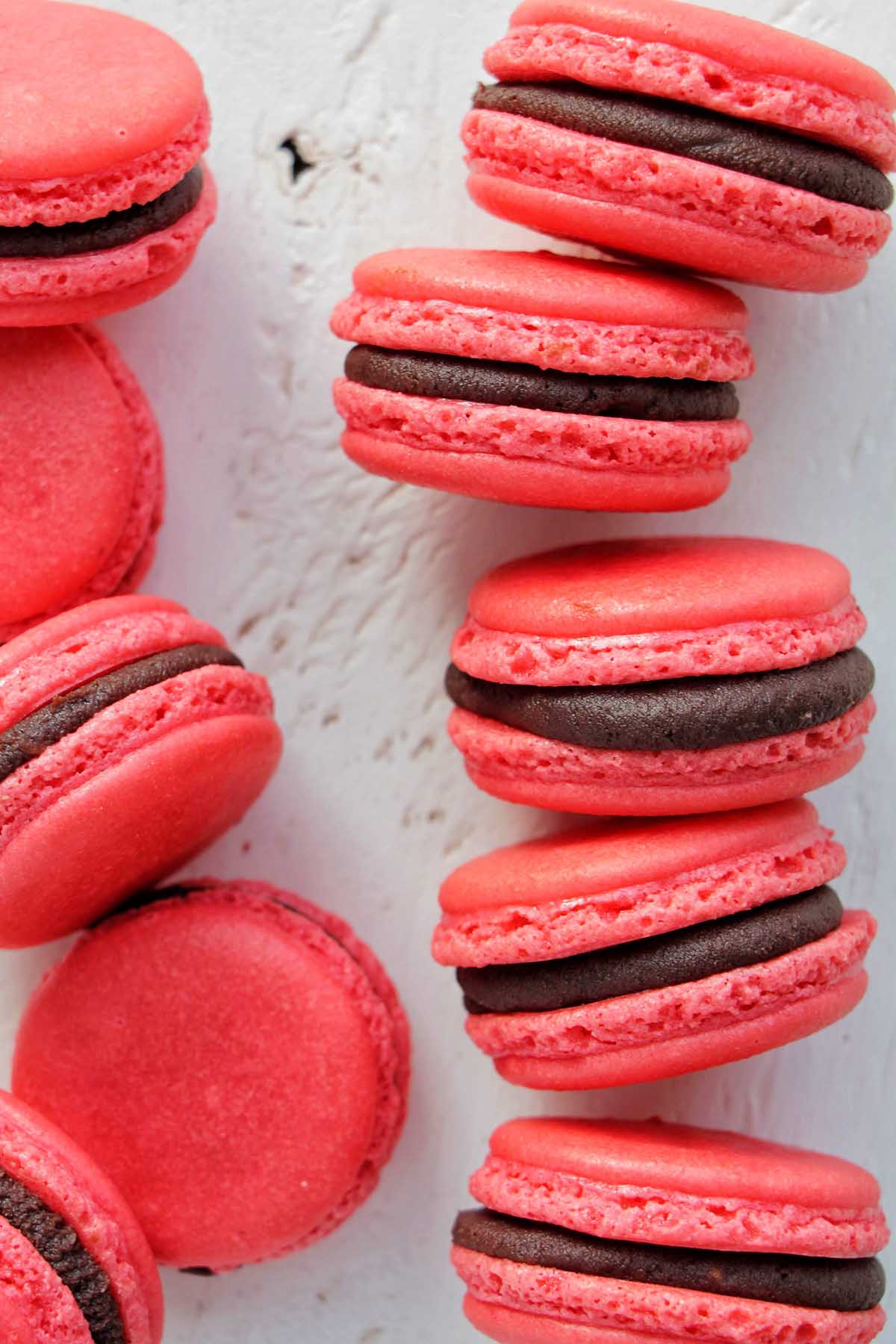
Want To Save This Article?
Enter your email below and we'll send it straight to your inbox. Plus, you'll receive new weekly recipe inspiration.
If you're a macaron lover, you have to try this raspberry macaron recipe filled with a raspberry fruit chocolate ganache.
These raspberry macarons are made with an Italian-style merginue for the shells. Then, I'm taking my classic chocolate ganache recipe and adding some raspberry fruit spread.
Whether you're an expert macaron baker or just starting out, this recipe will walk you step by step through everything you need to know. Plus, if you're running into any issues along the way, I've created troubleshooting guides to help you out.
You can always leave a comment below, and I'll do my best to help you out if you're having any problems.
Jump to:
What You'll Learn In This Recipe
- The qualities of a well-made macaron.
- How each of the ingredients affects the final raspberry macarons.
- The two most important steps to get correct in order to bake perfect macarons.
- Troubleshooting steps to try if your macarons aren't turning out correctly.
Enjoy learning tips about making macarons? Sign up for my free macaron template and email series. You'll learn my favorite tricks for achieving perfect macarons.
Qualities of a Good Macaron
There are some qualities your well-made raspberry macarons should have:
- Crispy (not too soft) top. You don't want the top to crack when you touch it.
- Small feet with a slight vertical rise. You don't want lopsided or ruffled feet that are spread out on the sides.
- Full, slightly chewy interior. You don't want a large hollow gap between the top and bottom, although this is one of the hardest things to get correct and can take some practice!
- Equal-sized top & bottom shells. You don't want small and large shells paired together to make one full macaron.

Ingredients You Need
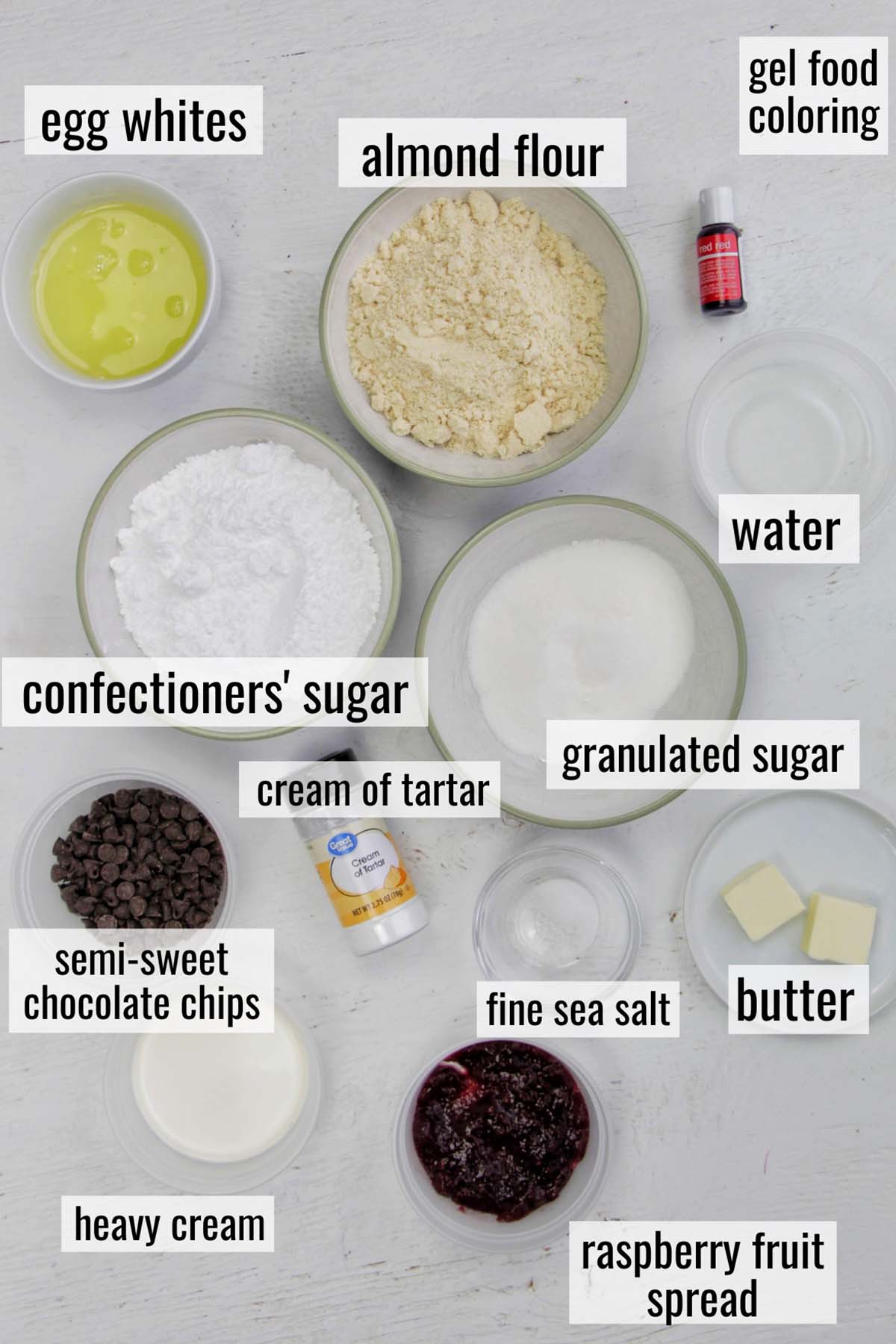
Egg whites: Egg whites are the base of the meringue. As air is beaten into the egg whites, some of the egg proteins unfold. These unfolded proteins turn into a strong network of air bubbles. This ingredient provides a strong base to the macarons.
Cream of tartar: Adding an acid to the meringue helps to stabilize the egg whites. This leads to a firmer, more stable merginue.
Granulated sugar: The sugar helps to build up the structure of the egg whites. Since Italian meringue is made with sugar syrup, you'll need to mix the granulated sugar with some water. Then, this mixture is cooked until it reaches 244°F (118°C) on a digital thermometer.
Super fine almond flour: This ingredient is made from almonds that are ground into a fine powder. Almond flour adds a subtle but delicious flavor to macaron shells. Make sure to sift the almond flour to remove any large clumps which could lead to bumpy shells.
Confectioners' sugar: This is another one of the dry ingredients used in raspberry macarons. Confectioners' sugar is sifted together with the almond flour to create a smooth shell.
Gel food coloring: Liquid food coloring will not work. Be sure to use a gel or powdered food coloring. These types of food coloring won't add too much liquid to your raspberry macaron batter, yet they create bright and vibrant colored shells.
If you're interested in learning more about the science of macarons, check out this article about macaron ingredients.
Also included in the photo are ingredients for the chocolate raspberry ganache macaron filling. Be sure to check out the recipe card below for the full measurements.
How To Make This Recipe
Here's a step-by-step photo guide to making this raspberry macaron recipe:
1. Prep Work
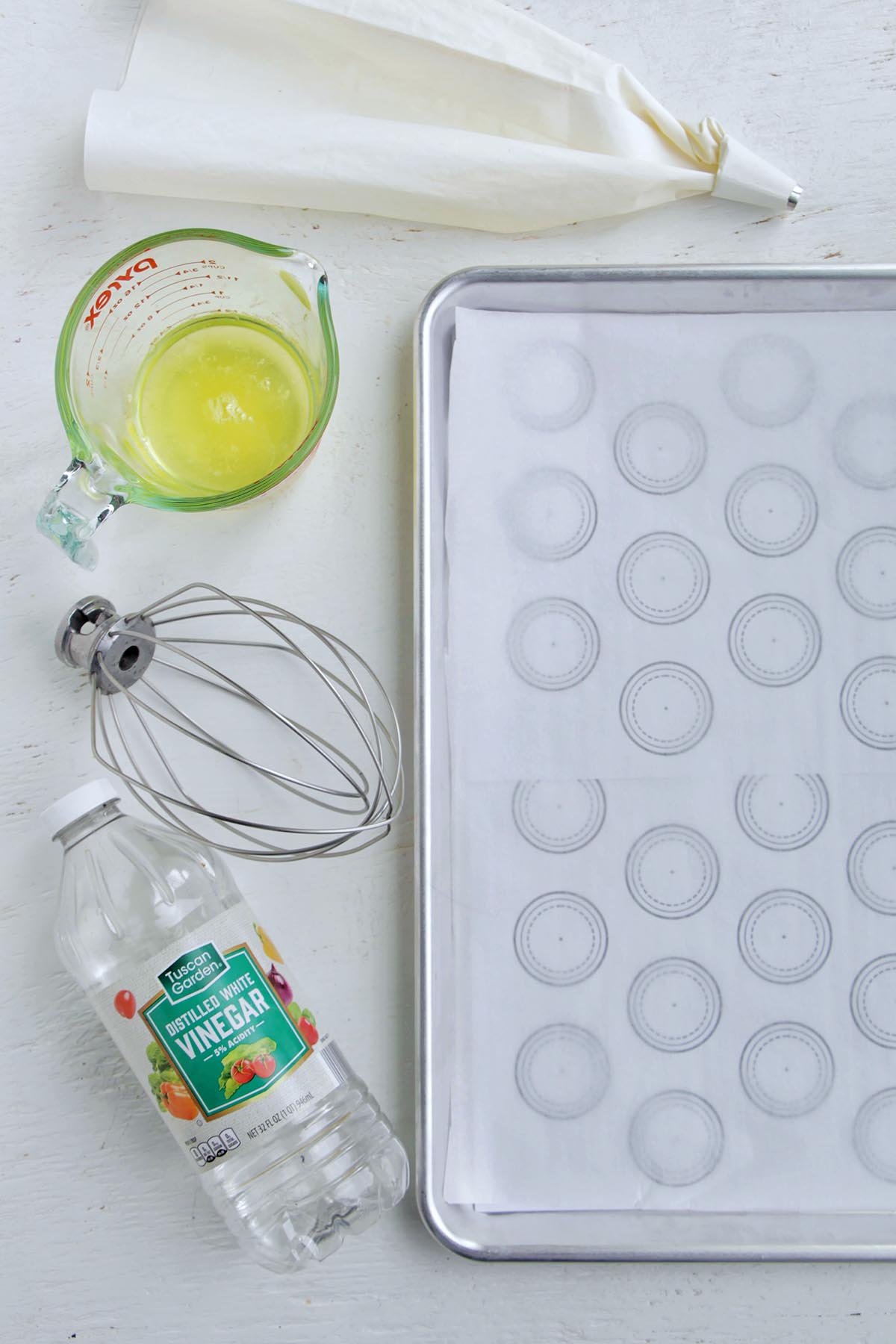
Before you start baking the raspberry chocolate macarons, there's some prep work you need to complete. This will help set you up for success:
- Separate the egg whites from the egg yolks, then allow the egg whites to come to room temperature. Egg whites foam best at room temperature (around 70°F - 80°F).
- Measure all of the dry ingredients using a digital kitchen scale. Measuring by weight ensures your ingredients are accurately weighed.
- Sift the almond flour and confectioners' sugar together twice. Discard any large pieces of almond flour that may cause your shells to be bumpy.
- Wipe down the stand mixer bowl and whisk attachment with a little white vinegar on a paper towel to remove any leftover oils. Fats interfere with the aeration of the egg whites and can ruin your meringue.
- Print off a macaron template. This piping template will help you pipe perfectly round circles. Place them on a light-colored sheet pan underneath a piece of parchment paper.
- Prepare your piping bag with a ½ inch round tip. Push part of the side of the piping bag into the piping tip to ensure nothing leaks out. Set the bag inside a tall glass, and pull the remaining top of the piping bag out over the outside of the glass to make pouring the batter easy and clean.
2. Make Italian Meringue
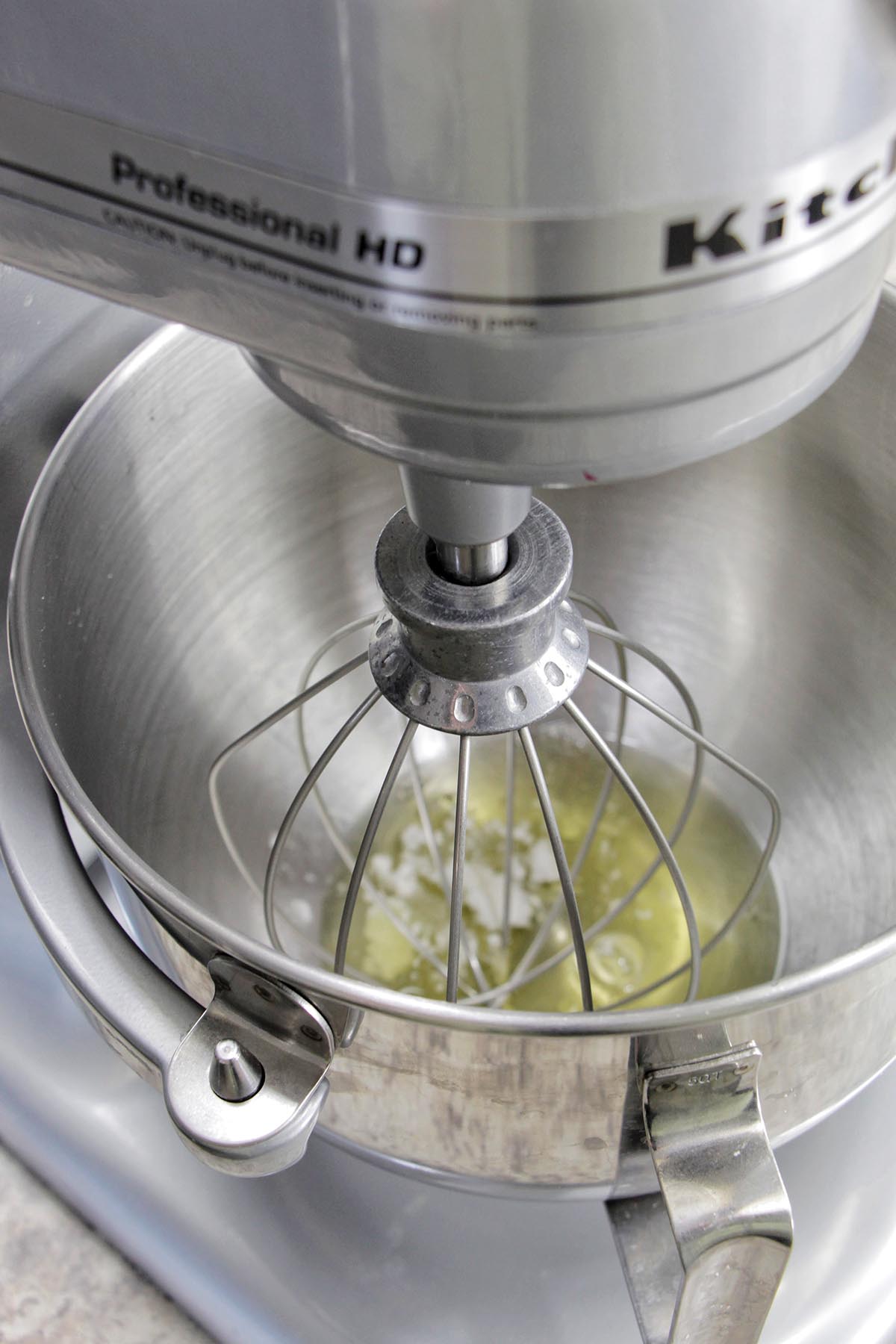
The first step to making raspberry macarons is learning how to make an Italian-style meringue. Add room-temperature eggs and cream of tartar to a stand mixer fitted with a whisk attachment.
Whip on medium-low speed (I use speed 4 on my KitchenAid mixer) until the eggs are very foamy, right before the soft peaks stage. This usually takes about 6 - 7 minutes.
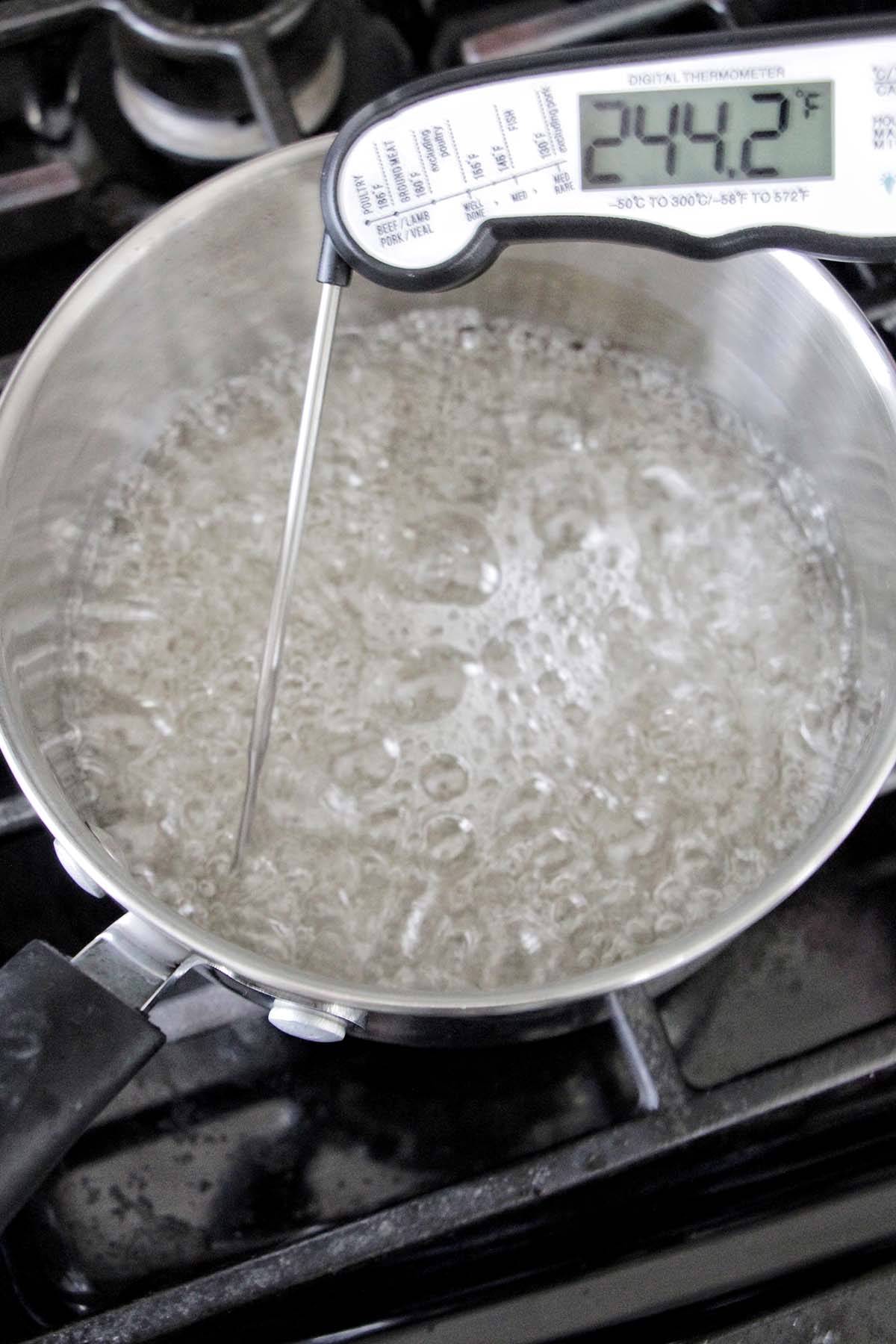
While the eggs are whipping, it's time to start on the sugar syrup. This is the part that makes Italian meringue unique.
Add granulated sugar and water to a saucepan. Then, place the saucepan over medium-high heat. You can stir the mixture if you want to help dissolve the sugar.
Cook the sugar until it reaches 244°F (118°C) on a digital thermometer. If you notice the eggs reach soft peaks before the sugar syrup is ready, reduce the mixer speed to low.
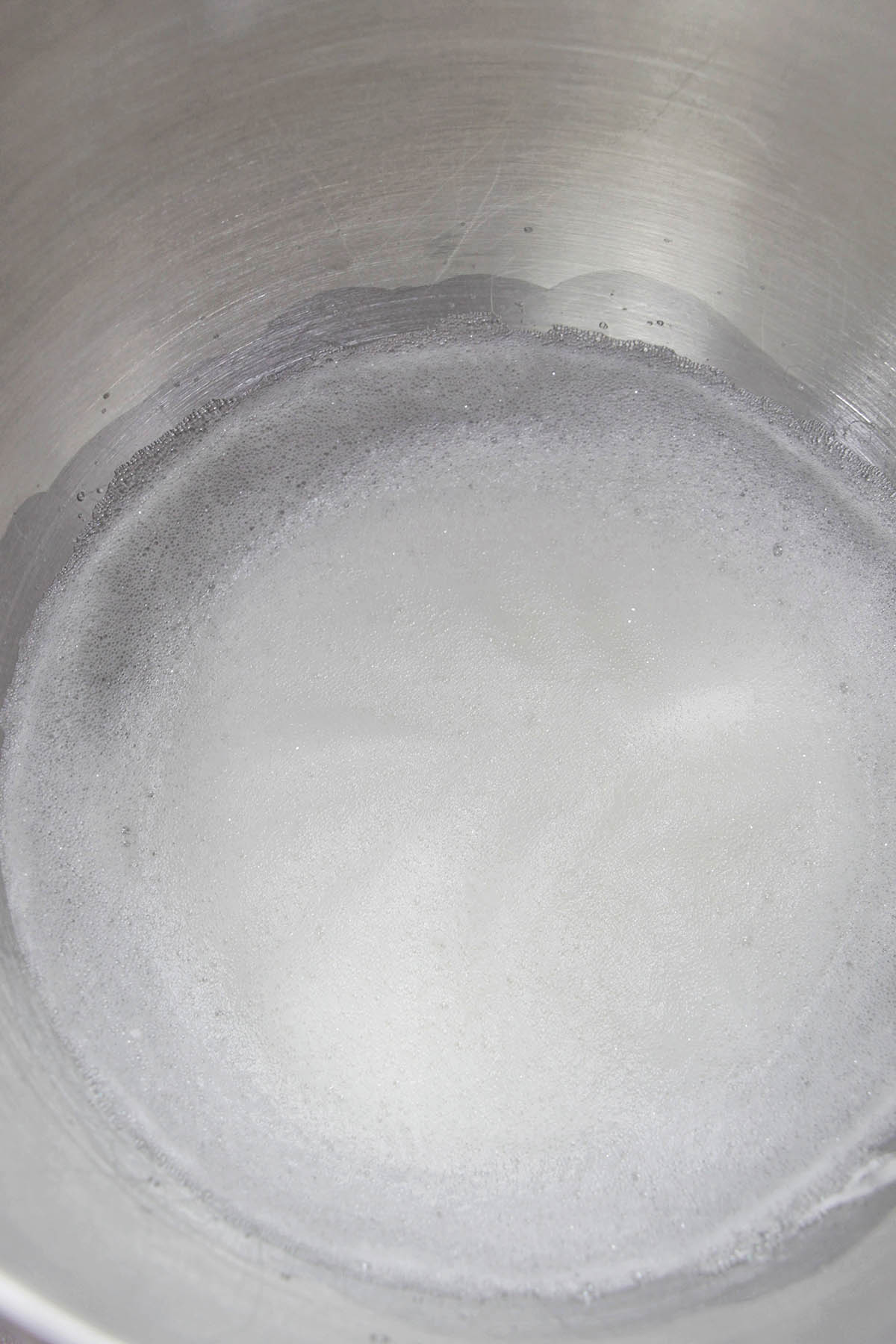
Here's a visual photo of what the foamy egg whites should look like.
Next, turn the mixer up to medium-high speed (I use speed 7 on my KitchenAid mixer), and slowly begin to pour the hot sugar syrup down the side of the mixing bowl.
Be sure the sugar runs down the bowl and doesn’t hit the whisk attachment or it will splatter on the side of the mixer bowl.
You'll want to do this step immediately after the syrup reaches 244°F. Don't let the syrup sit or it will begin to harden.
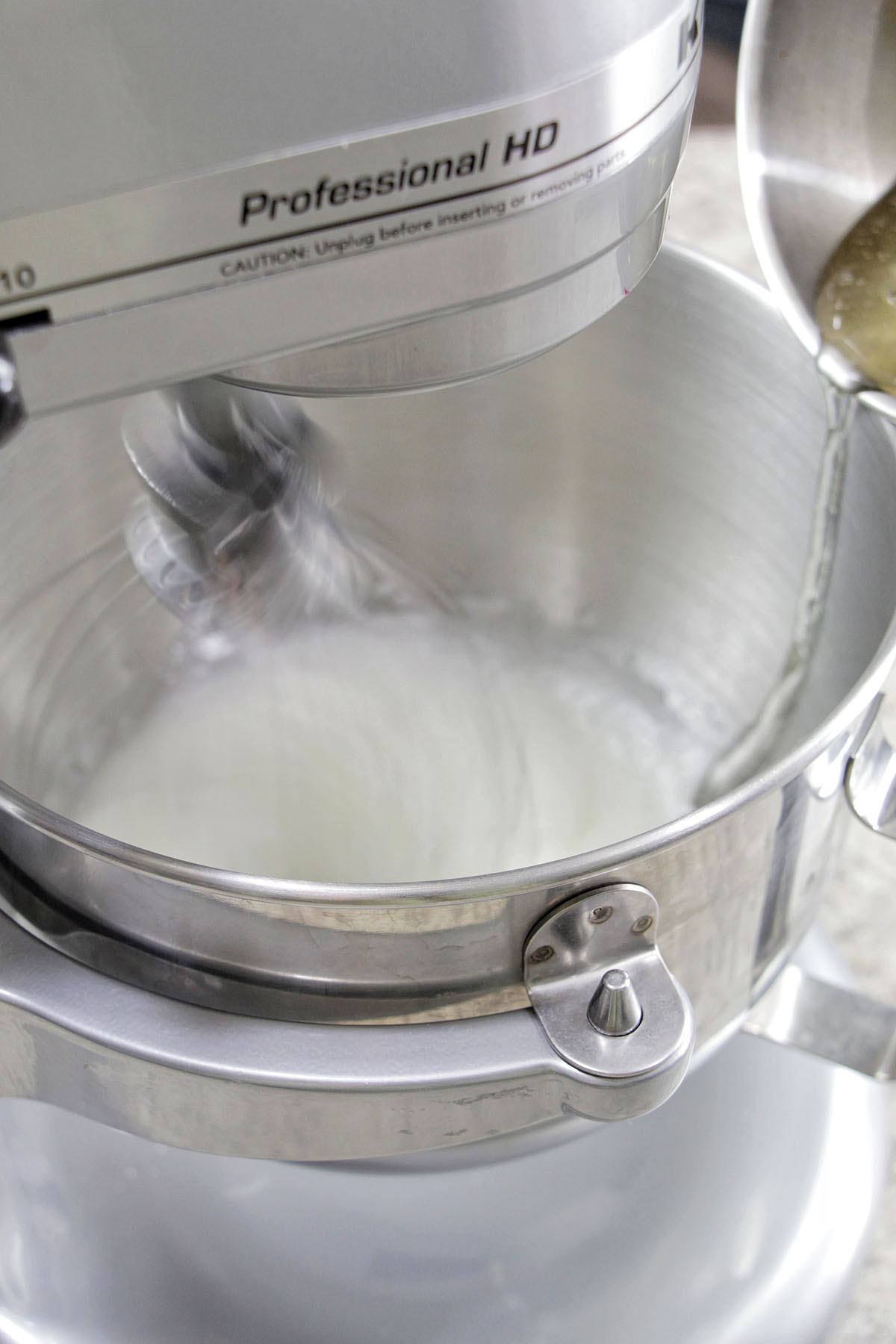
Continue to whip the Italian meringue for an additional 4 - 5 minutes after you've poured in all of the sugar syrup. You'll want to whip the meringue until you've reached stiff peaks.
If you're new to baking macarons, I'd suggest setting a timer. This will keep you aware of how long the meringue has been whipping.
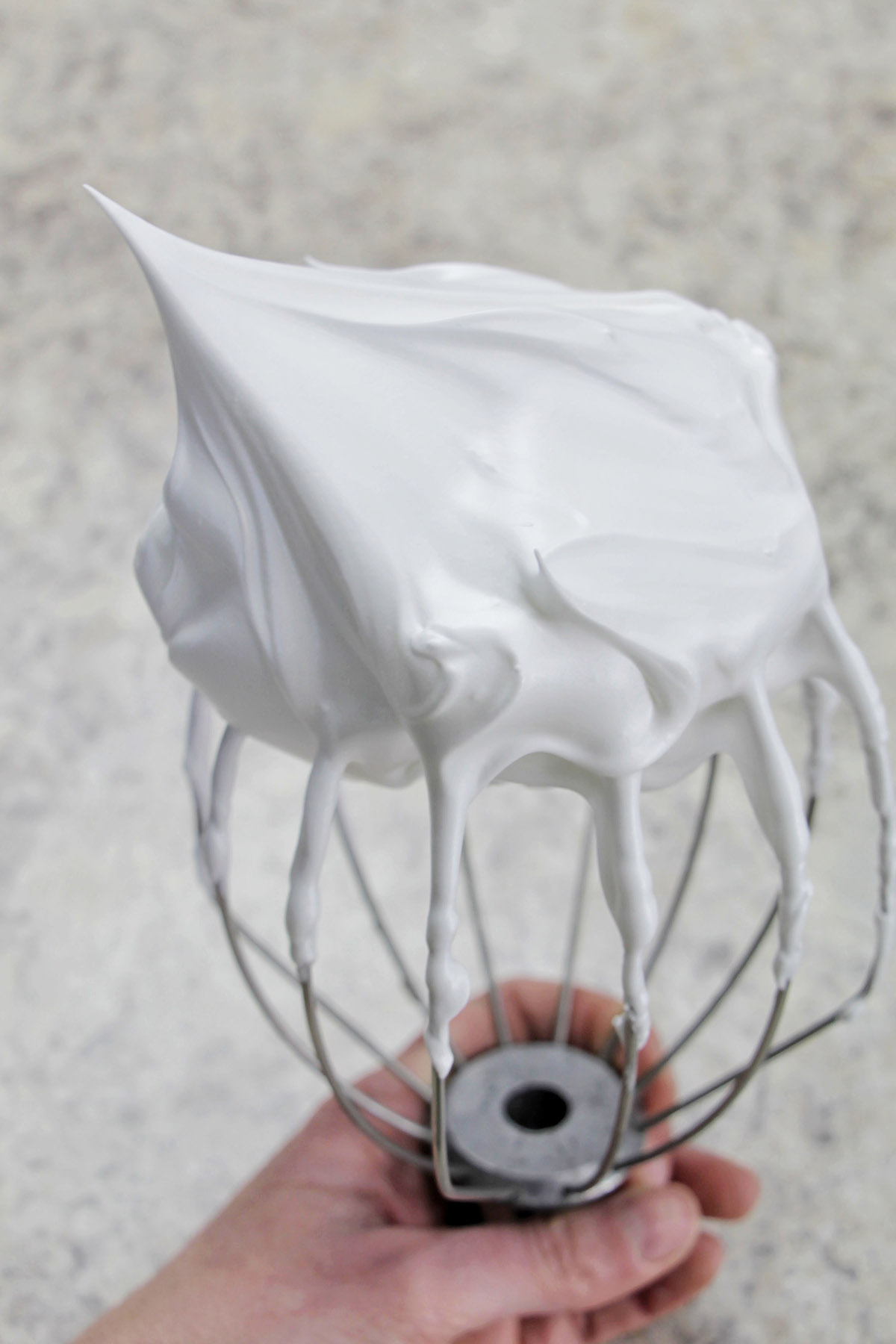
The stiff peaks meringue is a very crucial step to get correct. Here are some visual cues to look for to ensure your meringue has whipped to stiff peaks:
- You'll notice the meringue starts to ball up inside the whisk while it's mixing.
- Pull the whisk out of the mixer. A stiff peak should stand straight up (no curl at the tip).
- You can see pointy off-shoots of egg whites on the whisk when you pull it out of the mixer.
- You can fully flip the bowl over and nothing moves or falls out.
- The meringue feels sturdy (not flimsy).
- The egg whites hold the indentation that the whisk makes as it's whipping.
Since Italian meringue is known for being more stable, it's easy to over whip the meringue at this stage. Over whipped meringue will be too thick and can cause ruined macarons.
3. Mix In Dry Ingredients
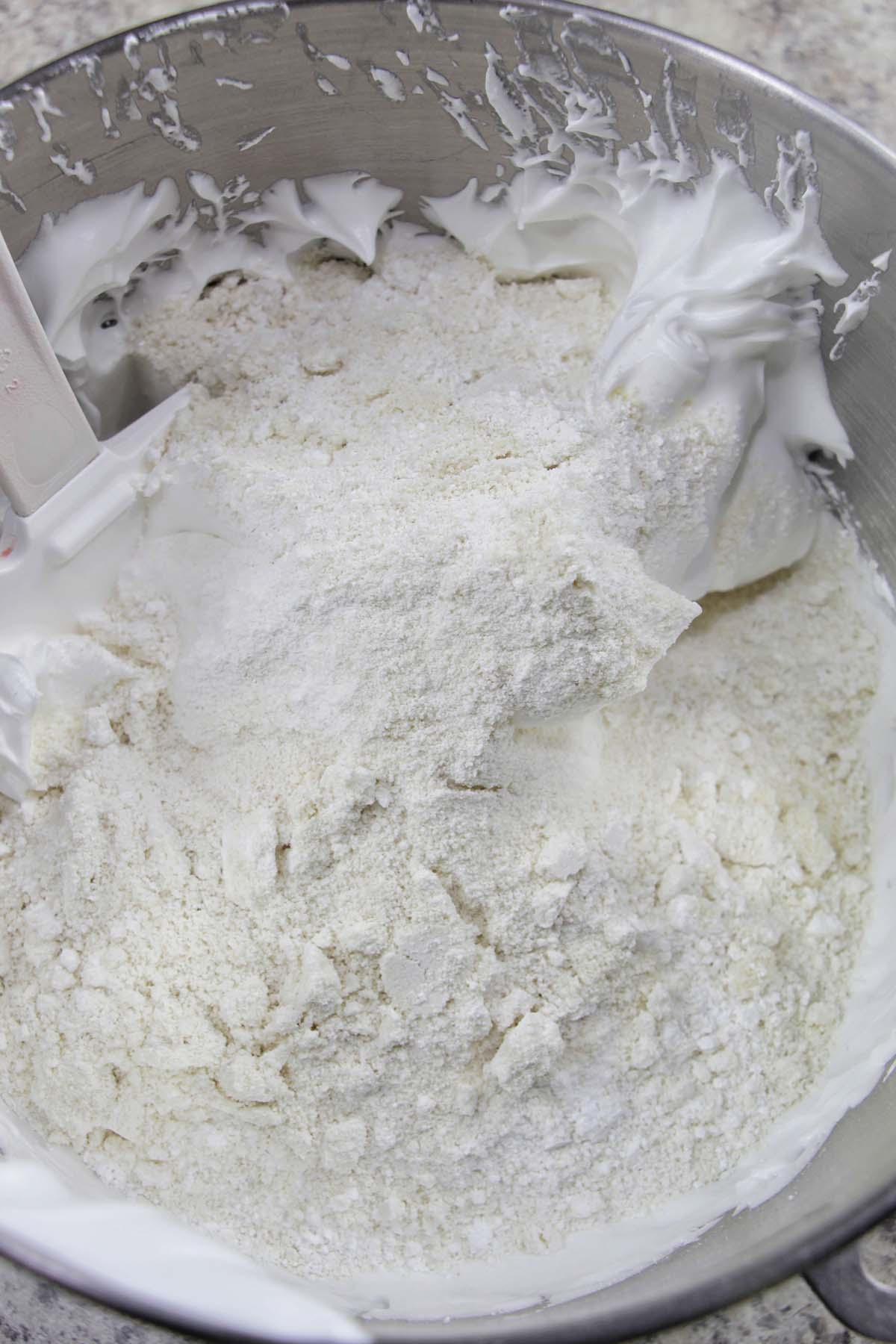
Grab a heavy-duty silicone spatula, and fold the sifted almond flour & confectioners' sugar into the meringue.
Continue until all the meringue is fully incorporated and no dry bits of almond flour remain on the bottom of the bowl.
4. Color Macaron Batter
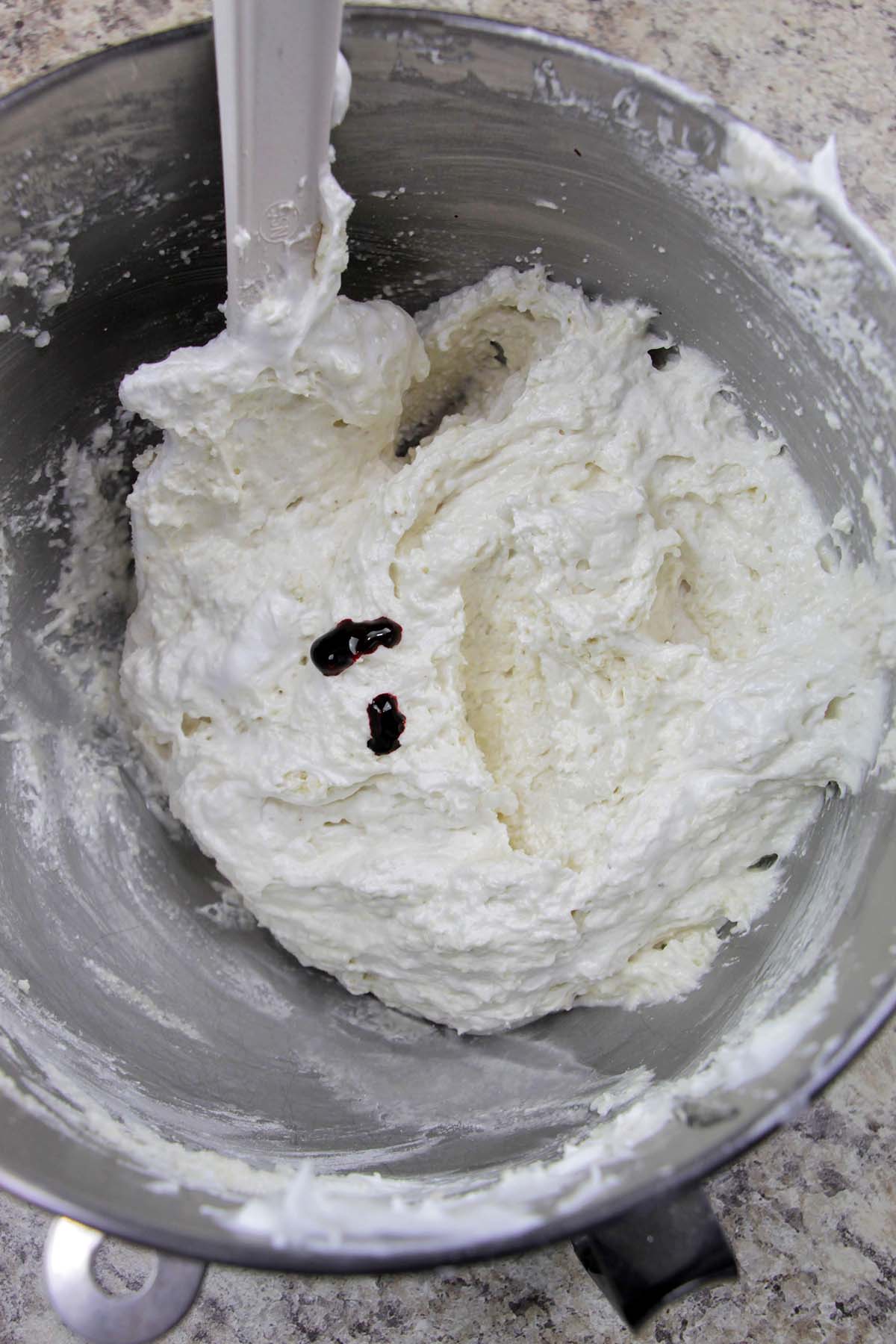
Add 5-6 drops of red or pink gel food coloring to the batter. It's important to use gel food coloring or powdered food coloring. Liquid food coloring adds too much water to the batter, and it could result in cracked shells or flat macarons.
5. Macaronage Batter
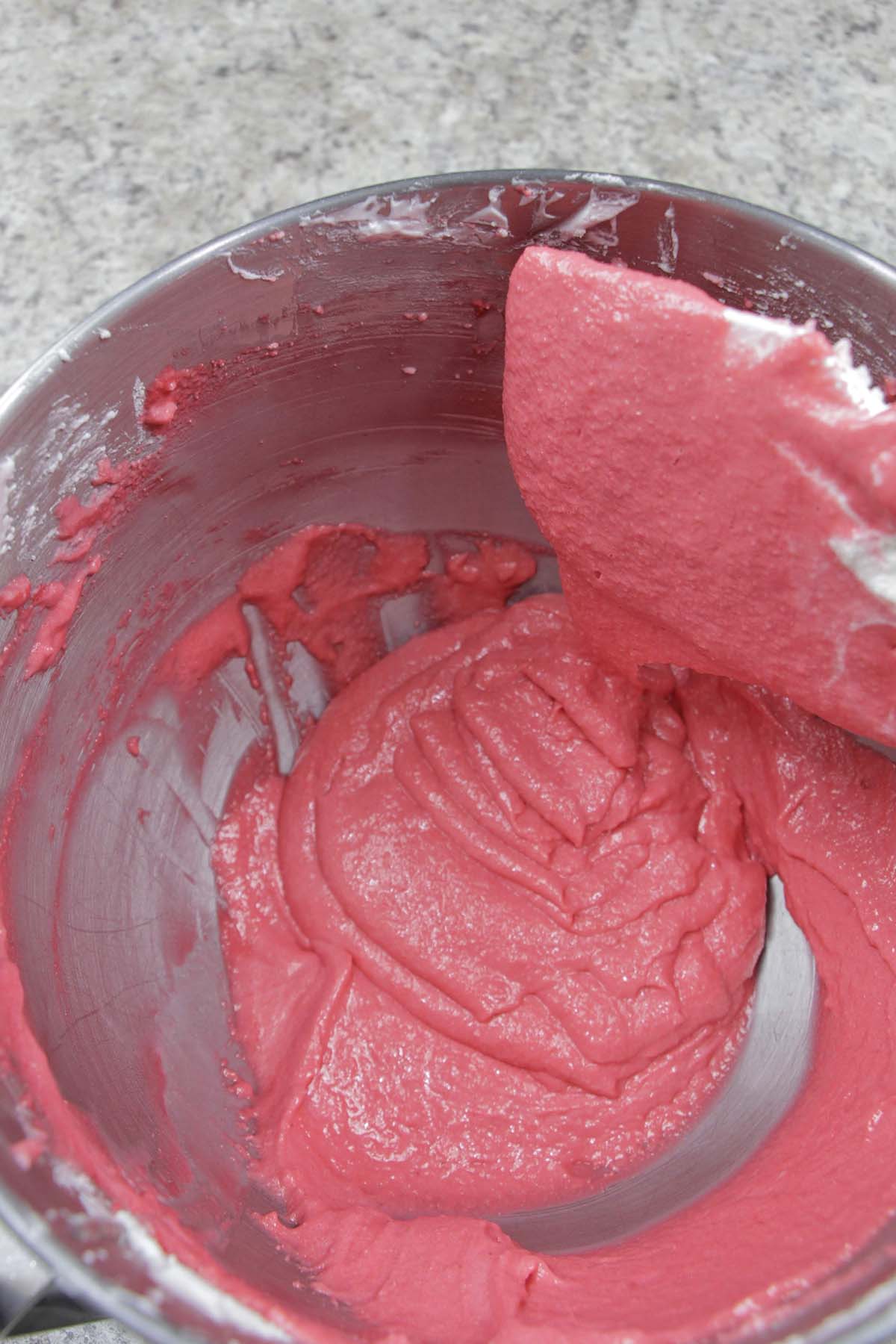
Next, it's time to macaronage the batter. This is another important step to correctly perform.
Macaronage is a term that refers to folding the dry macaron ingredients (almond flour and confectioners' sugar) into the meringue. This process smooths the mixture and helps the macarons bake with proper structure.
To properly macaronage, you will continue folding the batter until it reaches a lava-like consistency. You can test this by lifting your spatula and seeing if the batter drops almost like lava. Once it drops off the spatula, the batter that was dripped should fade back into the batter within 10 - 15 seconds (not immediately).
Additionally, the almond flour should look blended into the meringue (not lumpy).
Many home bakers who are new to baking macarons will over macaronage the batter. If you're unsure if your batter has been properly macaronaged, it's better to under macaronage a bit since the batter will still be worked in the piping bag.
If you've over whipped the Italian meringue, you'll notice that the batter will never thin out enough during the macaronage stage. Unfortunately, if this happens to you, you'll need to start over.
6. Pipe Macaron Shells
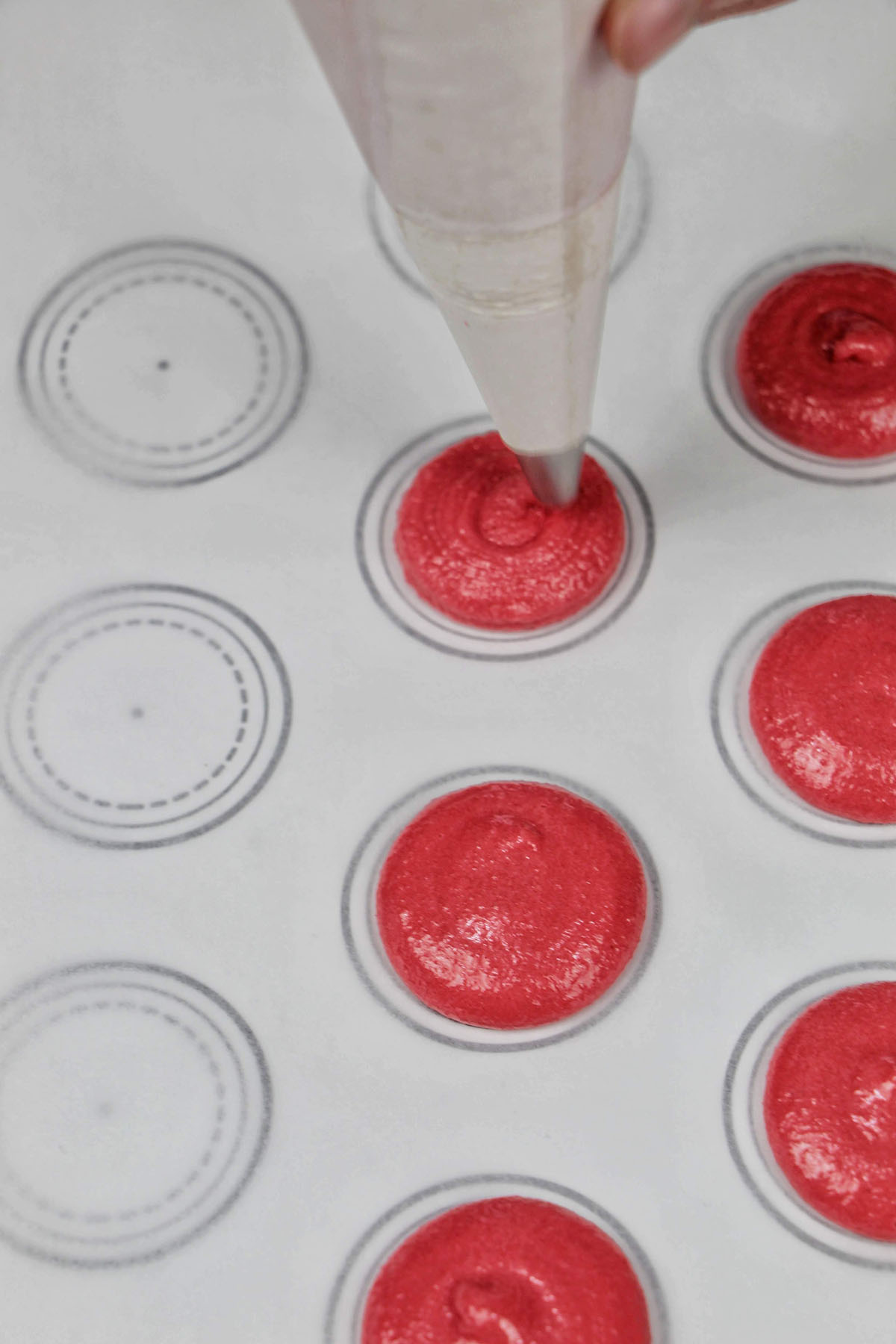
Pour the batter into the prepared piping bag. Hold the bag vertically, and gently pipe 1.5 inch circles. Once you have reached the desired size, release the pressure on the bag and twist your wrist without lifting up.
Here are some tips for improving your piping technique:
- Try not to move the piping bag to ensure you pipe an even circle.
- The macarons will spread slightly once they're piped, so pipe them .25" smaller than you want them to be after they have been baked.
- Flick your wrist after you've piped the desired size to cleanly finish off each macaron.
7. Release Air Bubbles
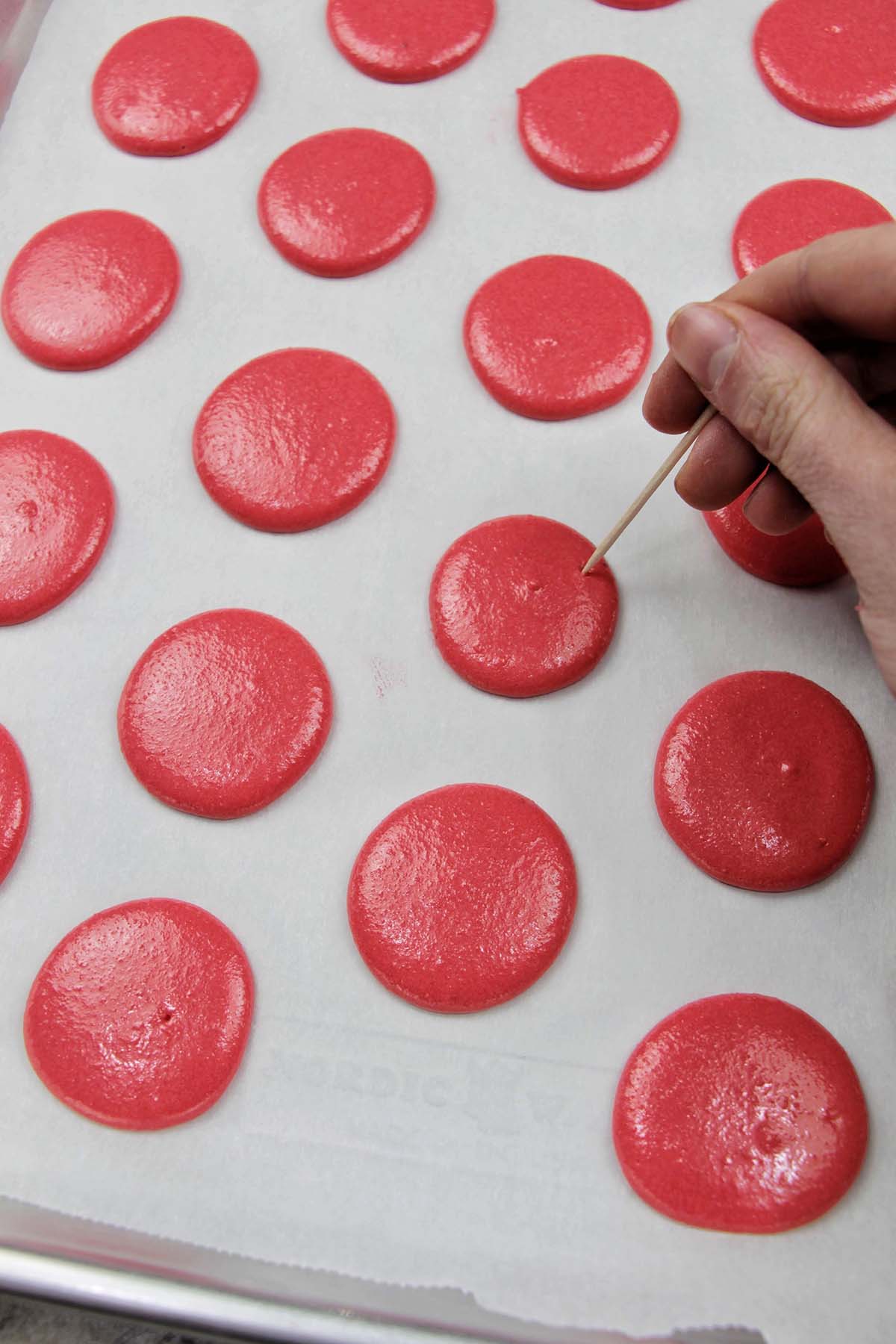
Tap the sheet pan down the counter a few times to release any air bubbles. You can tap the pan fairly aggressively, so don't be scared! Failure to do this could result in cracked macarons.
Then, you can pop any air bubbles that rise to the top with a toothpick.
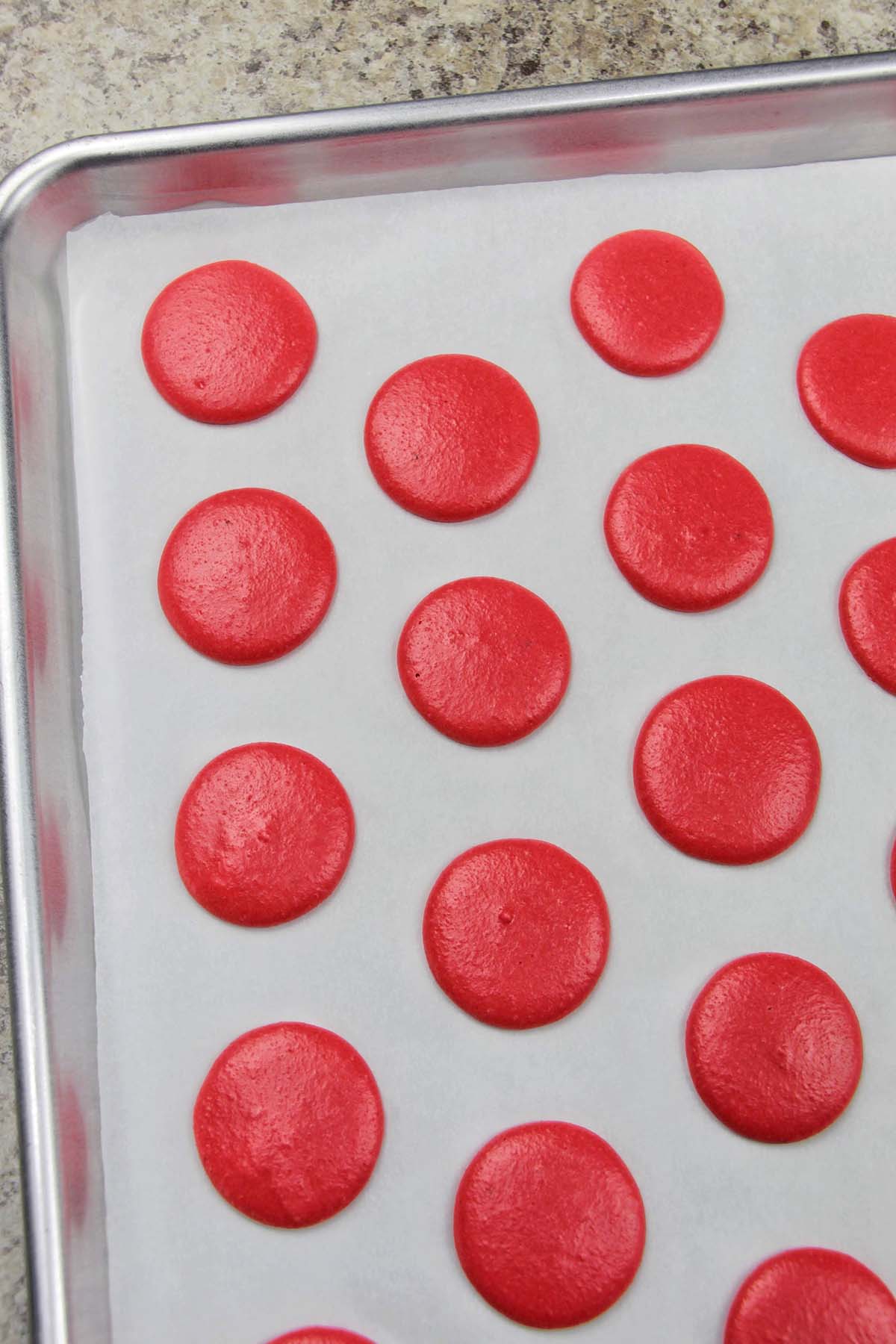
Before baking the macarons, allow the batter to sit on the counter and dry for 45 - 60+ minutes until a thin "skin" develops, and you can touch the tops without ruining the macaron. This may take up to 90+ minutes if you live in a humid climate or it's a rainy day.
If you're having trouble with this, check out my tips for how to fix macarons that aren't drying.
While the macarons are drying, heat your oven to 300°F (150°C). If this is your first time making macarons, you might want to experiment with the oven temperature to find out the best temperature range for your home oven.
Once the macarons are done drying, bake one sheet at a time on the center rack of the oven for 19 - 23 minutes. Check that the macarons have fully baked using the following tests:
- The feet and the edge of the macarons feel firm when you gently touch them.
- It feels like you could forcibly lift the macaron shell off the parchment paper if you needed to (don't actually do this, just use it as a test).
- If you touch the shell and it wiggles, is still sticky, or is wet, you know the macarons need longer to bake.
8. Make Raspberry Ganache
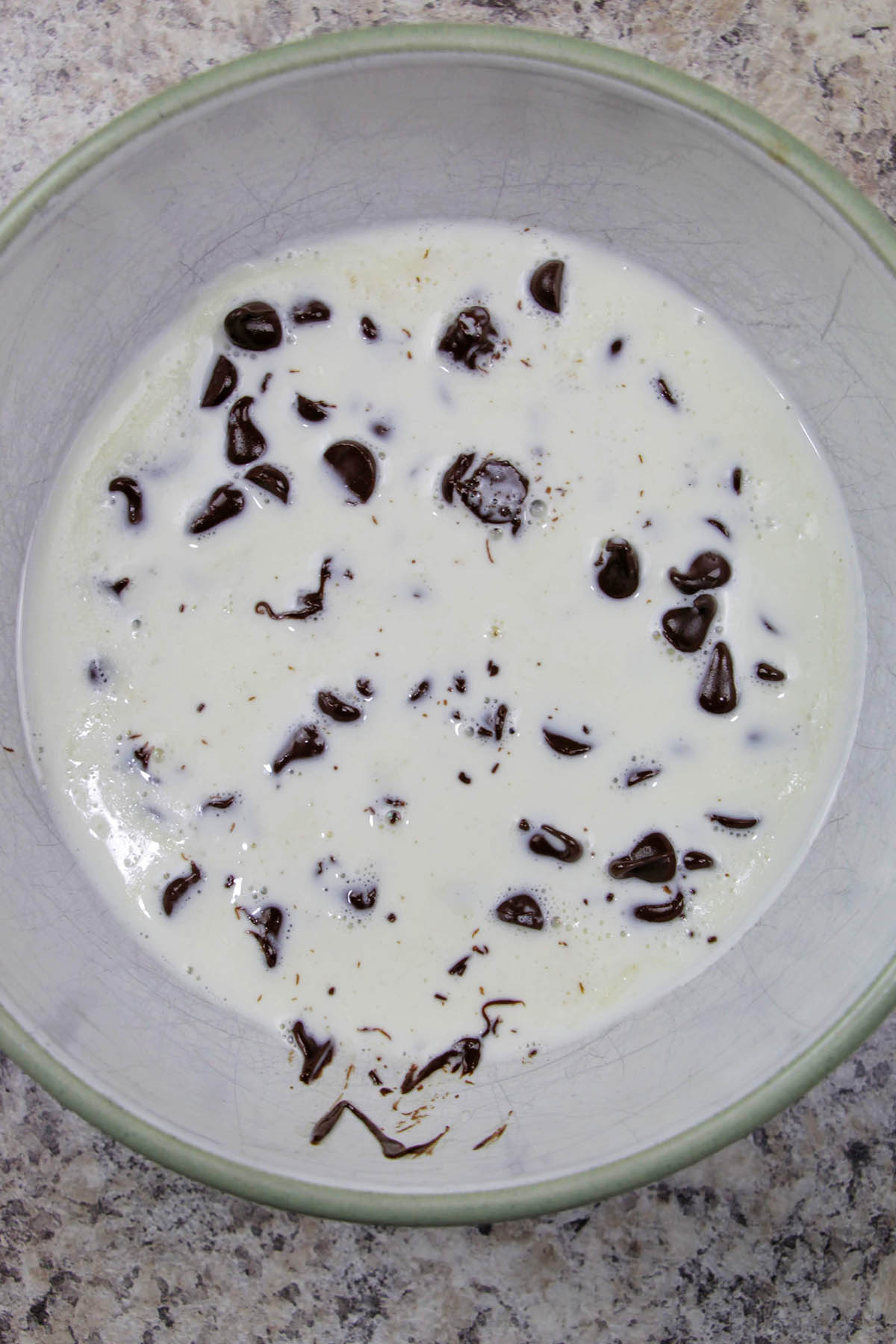
Next, it's time to make the raspberry macaron filling. This filling is a base of chocolate ganache that's filled with raspberry fruit spread.
First, add semi-sweet chocolate morsels to a heat proof bowl.
Then, in another bowl, heat heavy cream in the microwave on 100 power (high) for 45 - 60 seconds until the heavy cream begins to steam. Be sure the heavy cream does not boil over.
Then, immediately pour the heavy cream over the chocolate. Make sure all of the chocolate is submerged under the cream.
Allow the mixture to sit, without stirring, for 3 minutes so it can melt.
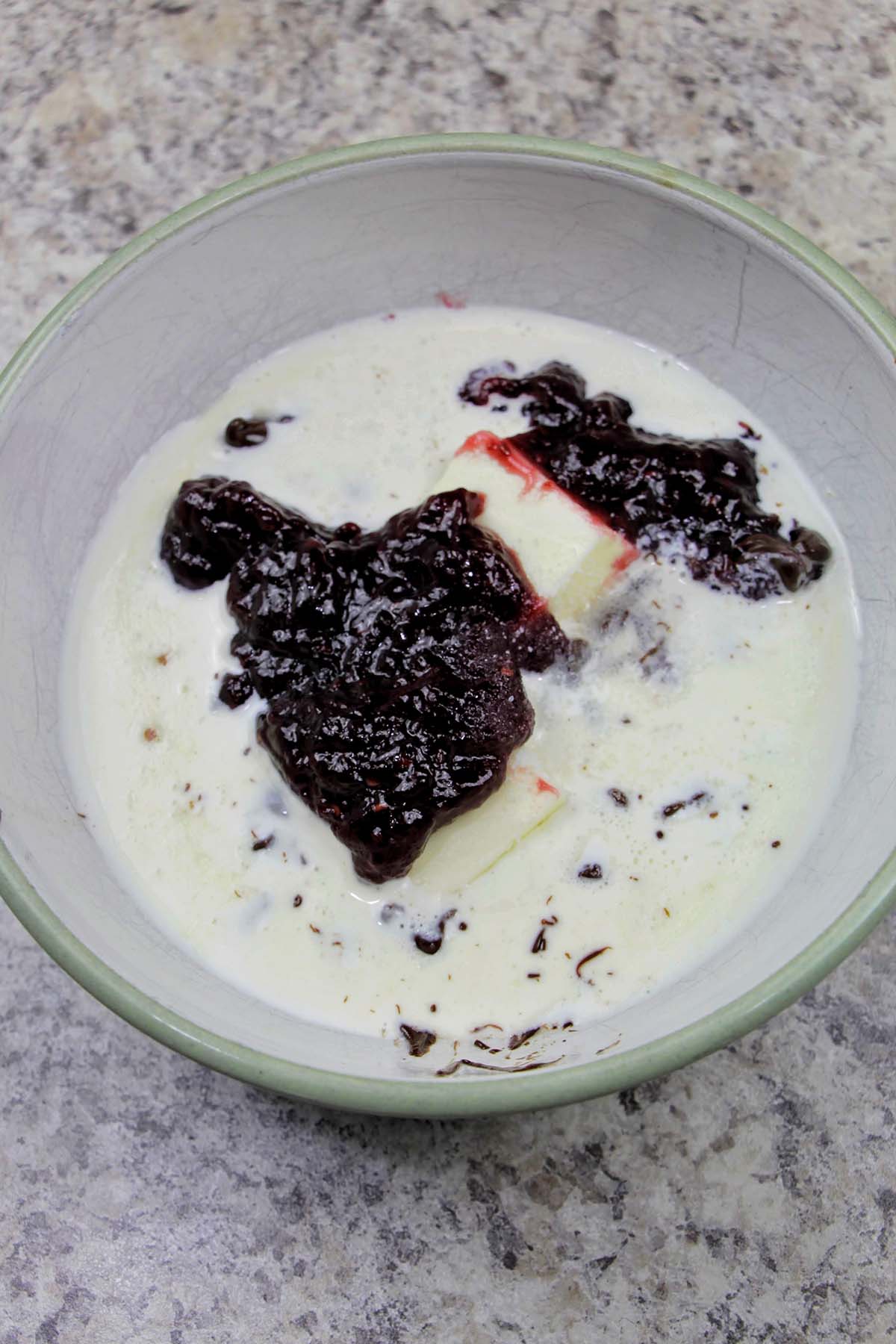
Once the chocolate has melted, add raspberry fruit spread, salt, and butter to the chocolate. Stir until the mixture is smooth and fully blended.
If there are still bits of chocolate or butter after stirring for about 60 - 90 seconds, heat the mixture in the microwave for an additional 15 - 30 seconds. This helps the ingredients to soften so you can then stir until a silky, creamy consistency forms.
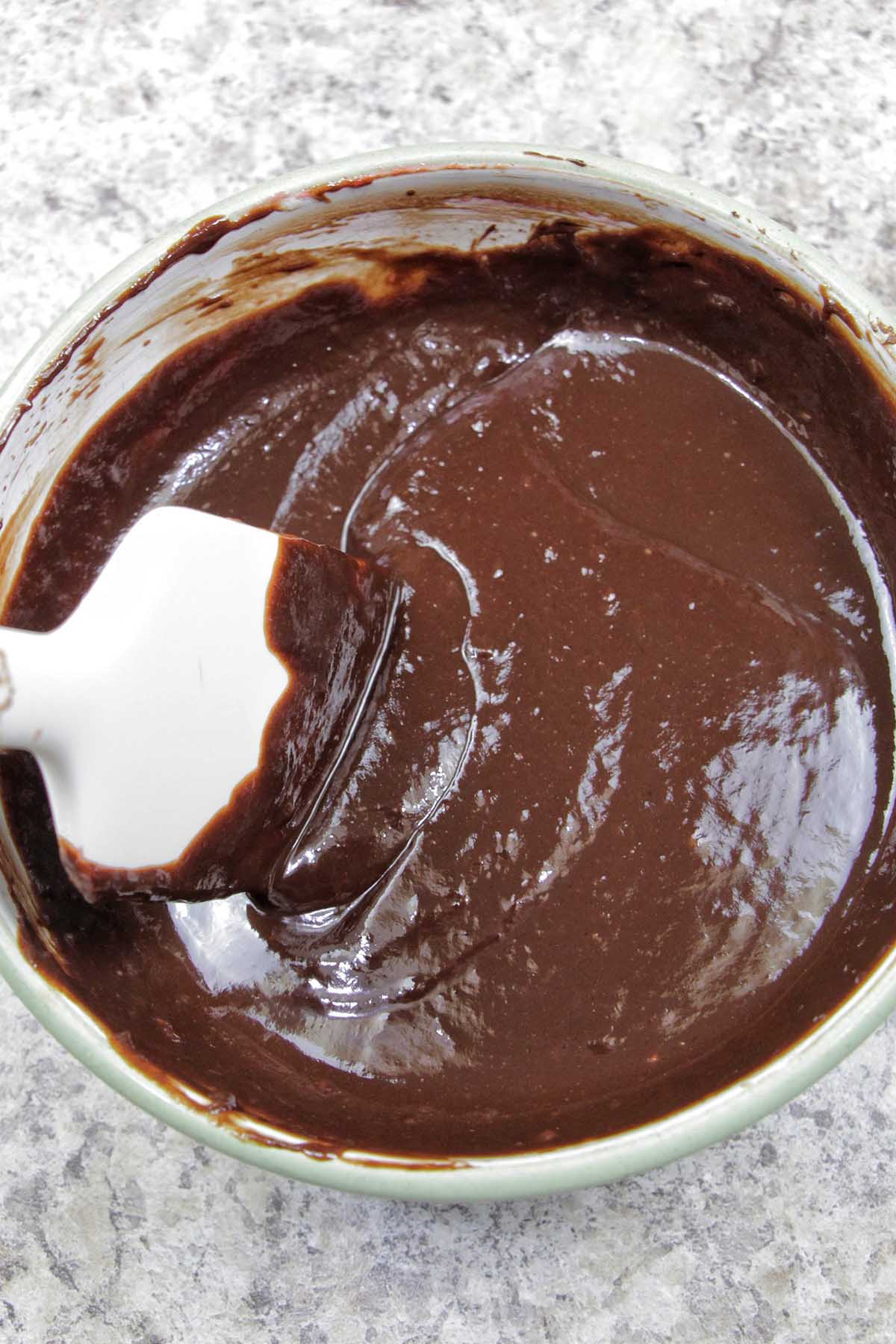
At this point, the ganache will be too runny to pipe. Place the bowl in the fridge and allow the mixture to cool until it’s firm enough to pipe, which takes about 90 minutes.
If you want to make the raspberry ganache filling 2 - 3 days ahead of time, simply store it in the refrigerator in an airtight container. Then, allow the ganache to come to room temperature before piping.
9. Fill Macarons
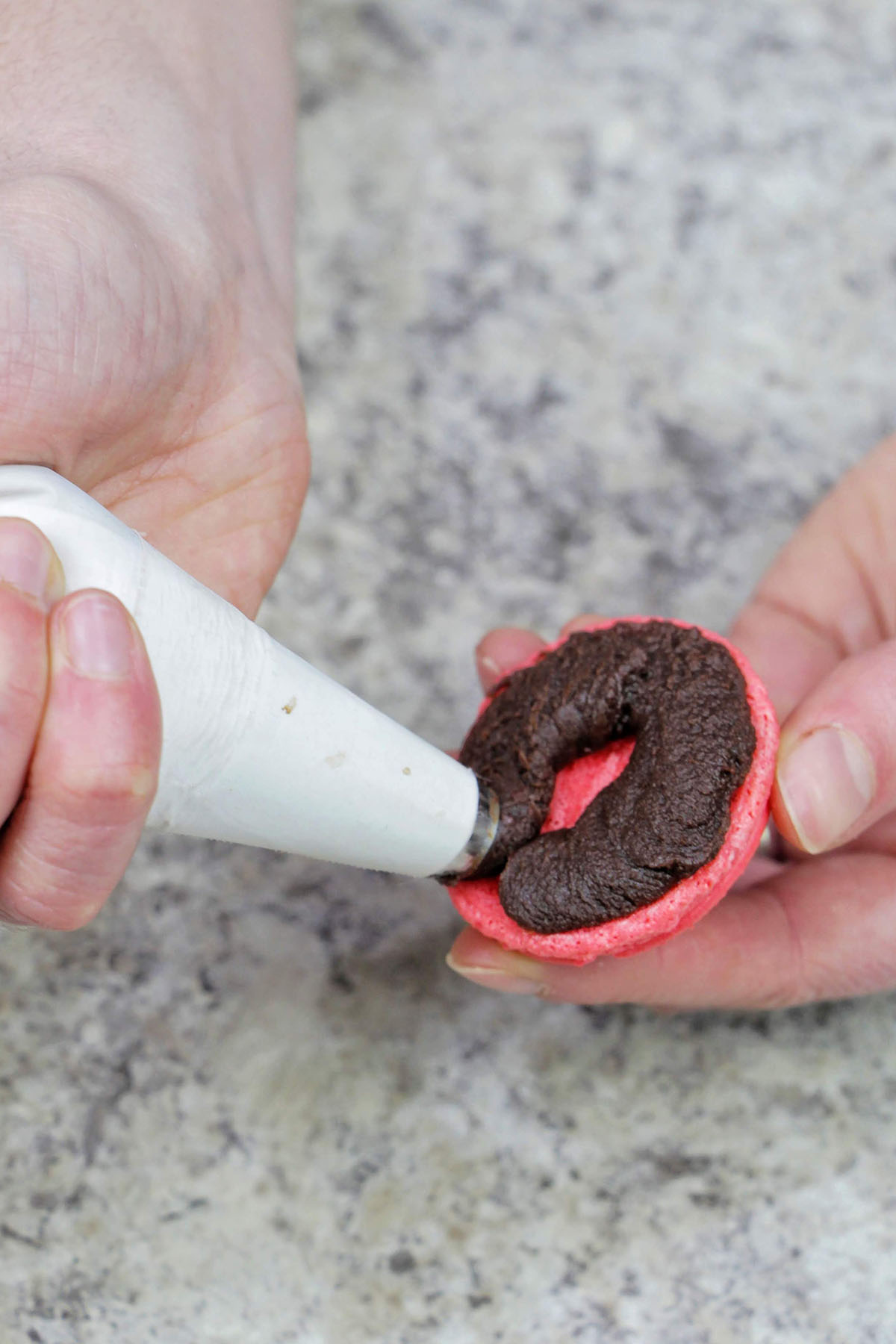
Finally, allow the raspberry macarons to fully cool. Then, it's time to pipe the chocolate ganache filling.
Match up the pink macaron shells so they are paired with a similar size/shaped shell.
Pipe 1 teaspoon of ganache on one side of the macaron shell using a ½ inch round piping tip. Gently place the matching macaron on top of the ganache.
If you want a little more chocolate ganache filling, double the recipe listed below so you have more filling to pipe.
Don't forget to mature the macarons with the filling in the refrigerator overnight. This will allow the macarons to slightly soften and develop a deeper flavor.
These raspberry chocolate ganache macarons will last up to 7 days when stored in an airtight container in the refrigerator or up to 1 month in the freezer. You can read more about my tips and tricks for macaron storage.
Expert Tips
There are a few crucial steps you must get correct in order to achieve perfect raspberry macarons:
First, you must perfectly whip your meringue. Both over-whipped and under-whipped meringue can cause many problems such as cracked macarons, ruffled feet, or soft shells.
Here are some visual cues you can use to know that your meringue has whipped to stiff peaks:
- You'll notice the meringue starts to ball up inside the whisk while it's mixing.
- Pull the whisk out of the mixer. A stiff peak should stand straight up (no curl at the tip).
- You can fully flip the bowl over and nothing moves or falls out.
- The meringue feels sturdy (not flimsy).
If you're a visual learner, here's a photo guide that shows the various stages of meringue:
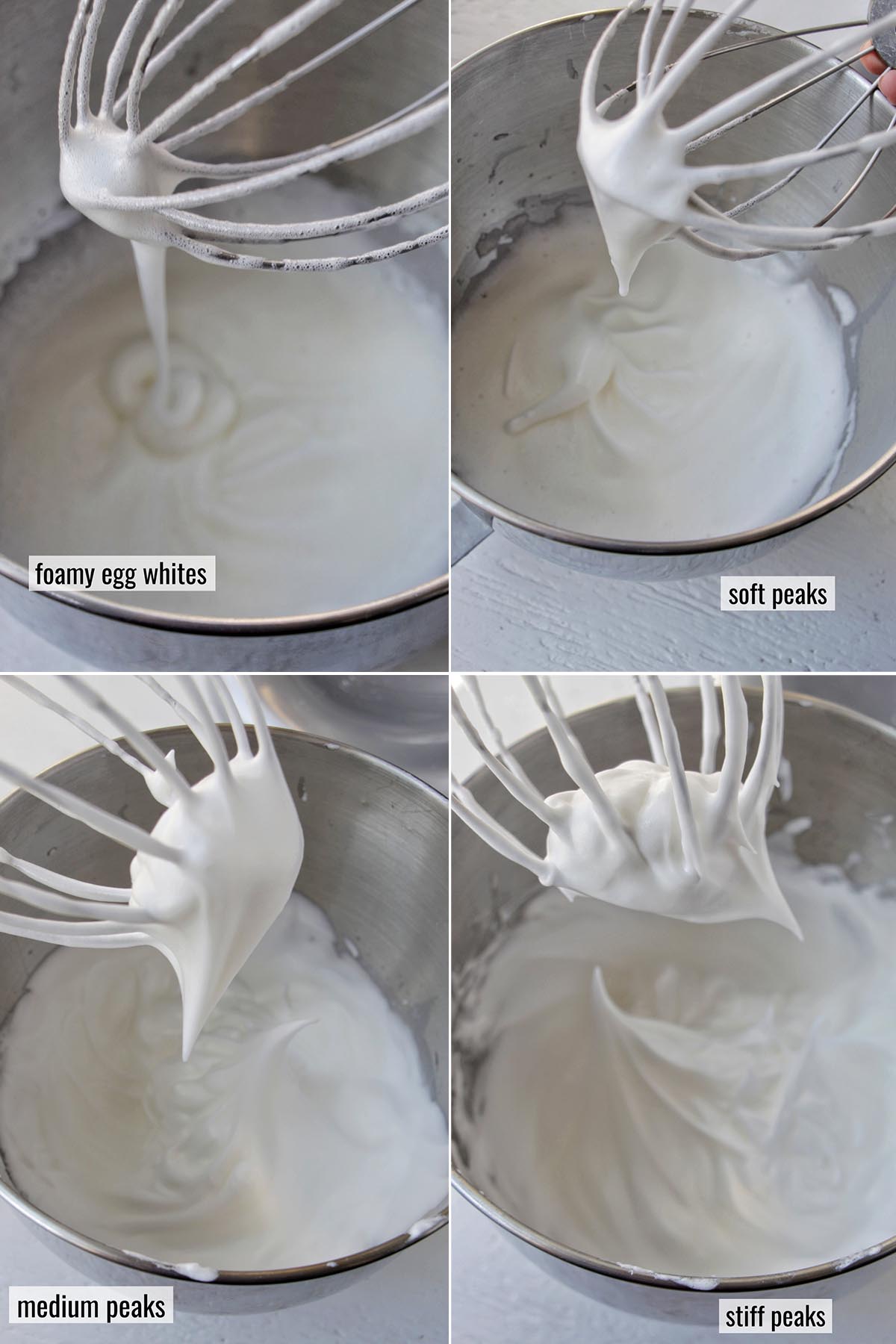
Next, you'll need to properly macaronage the macaron batter. This refers to the process of folding the egg whites into the almond flour and confectioners' sugar.
To macaronage, slowly spread the mixture along the side of the bowl, then wipe it back down. Be sure to do this gently.
Repeat this process until the mixture has reached a smooth, shiny, and flowing consistency. You can test this by lifting your spatula and seeing if the batter drops almost like lava.
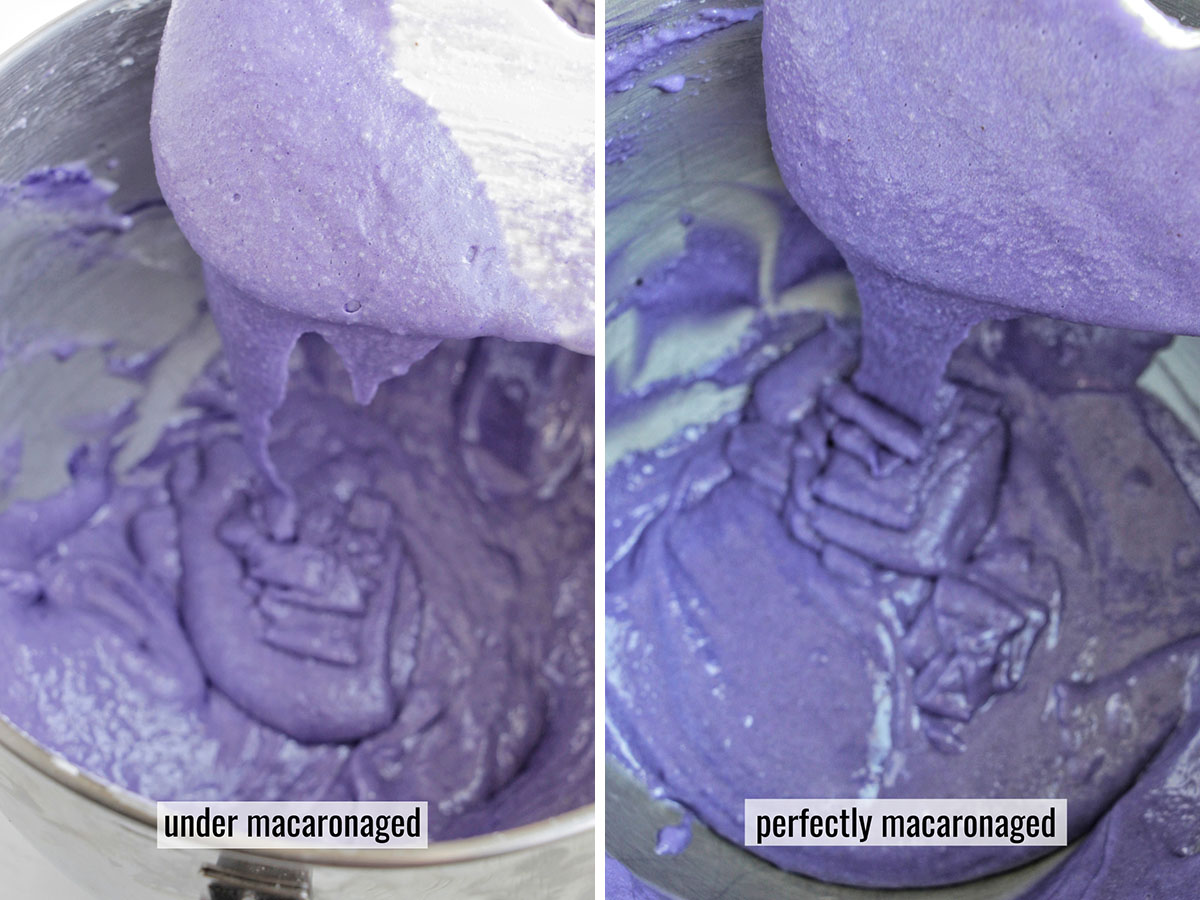
Once the batter drops back into the bowl, it should take about 10 - 15 seconds for the ribbon that formed to "disappear" back into the rest of the batter.
Over macaronaged batter is very thin and runny. When you pour it off the spatula, it almost immediately disappears back into the macaron batter.
When in doubt, it's better to under macaronage. A batter that's too runny will not produce the macarons you're looking for.
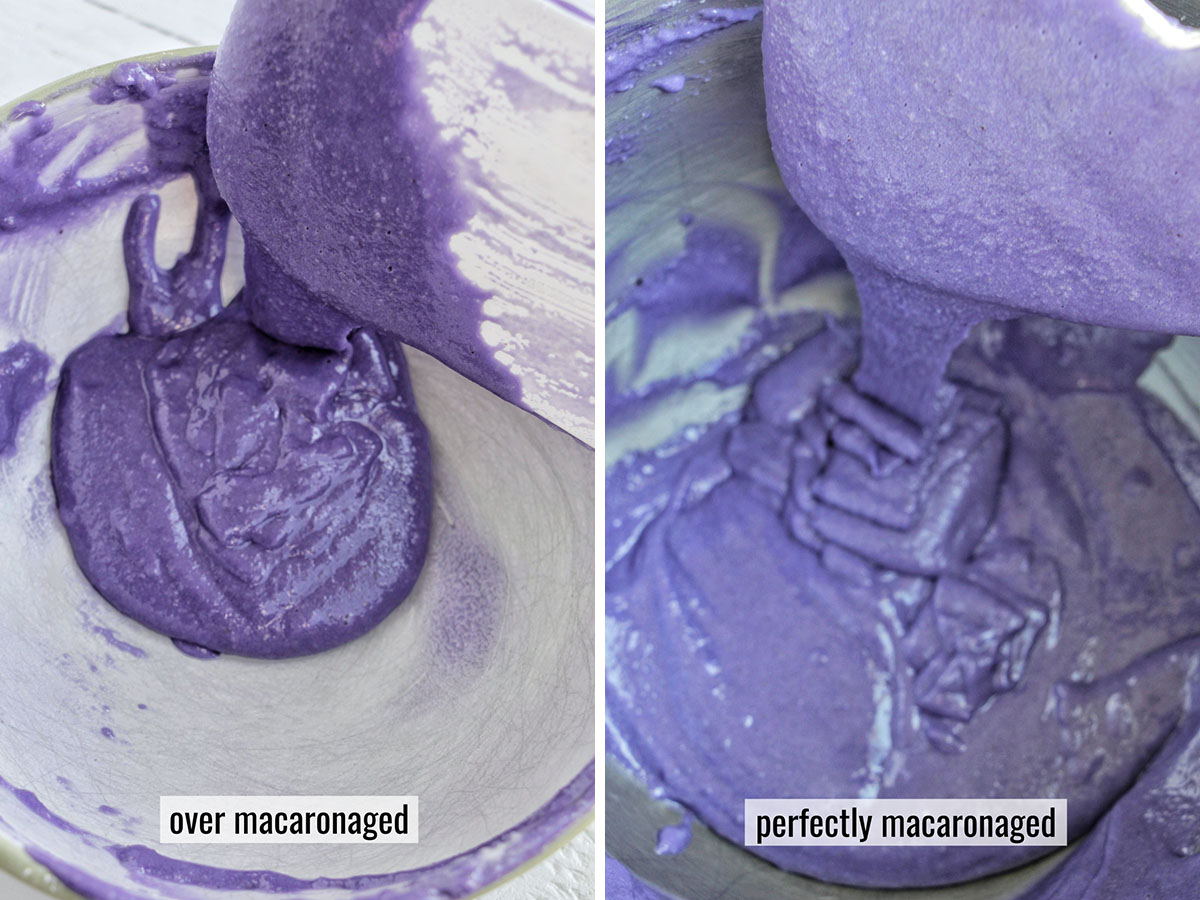
Finally, it's important to dial in your oven temperature. Slight changes in temperature can make the difference between ruined macarons and perfect macarons.
I'd suggest conducting an experiment with your home oven to find the perfect temperature range since every home oven varies slightly with the amount of heat it radiates.
Here's an example of my home oven experiment and the results I got from various temperatures. You can read more about how to conduct your own oven temperature experiment if you're interested.
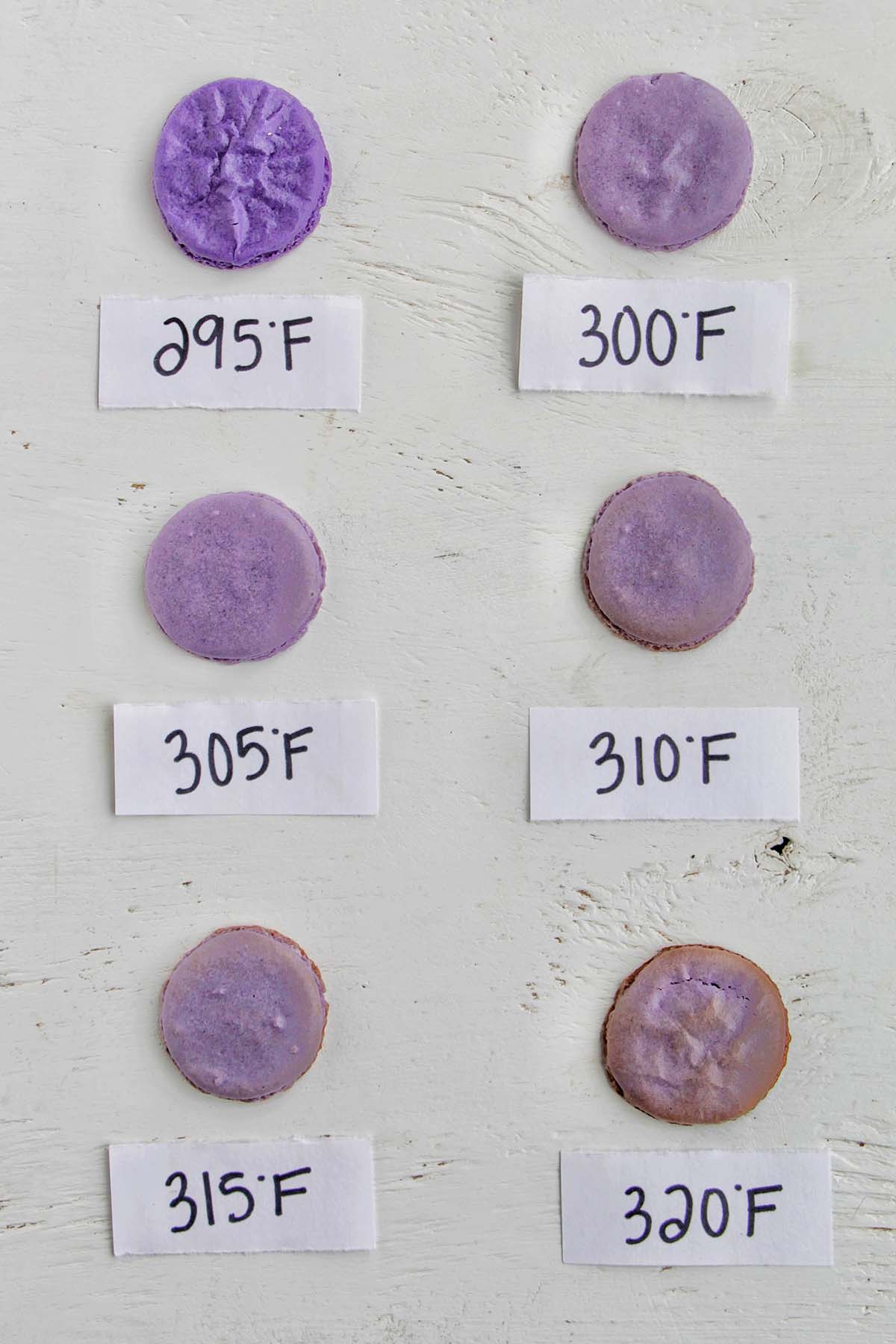
You can download my free ebook about four reasons your macarons are failing if you need some additional help!
Macaron Troubleshooting Tips
If you're having trouble with your raspberry macarons turning out correctly, take a look at these troubleshooting tips.
As always, remember that it takes some trial and error to bake macarons at home. Don't give up on your first or second attempt, keep going!
You can always refer to my macaron troubleshooting video or leave a comment below, and I'll do my best to help you out.
Here are a few common causes of flat macarons:
1. The oven is too hot or too cold: If your oven is too low, you'll notice that the macarons won't properly rise. Not only will they be flatter than a normal macaron, but the feet will be short (under 2 millimeters), and the tops will likely be wrinkly or indented.
On the other hand, if your oven is too hot, the shells will be flat because proper feet will not form. The macarons will bake too quickly on the outside, leaving a moist interior that doesn't properly rise.
2. You under whipped the meringue: You didn't whip your meringue to stiff peaks. Under whipped meringue won't be strong enough to properly rise in the oven. It can lead to flat, wrinkled, or weak macaron tops.
3. You over macaronaged your batter: Another common issue that results in flat macarons is over macaronaged batter. Macaronage is a term that refers to folding the dry macaron ingredients (almond flour and confectioners' sugar) into the meringue. This process smooths the mixture and helps the macarons bake with proper structure.
When you over macaronage, you'll notice the batter is very thin and easily falls off the spatula. You'll also notice that the batter spreads really easily when piped. It might even fall out of your piping bag when transferring from one circle to the next on your piping template.
If you're still having trouble, check out my troubleshooting guide for flat macarons.
Here are a few common causes of cracked macarons:
1. Your oven is too hot: Most likely, cracked macarons are related to oven temperatures that are too hot. To fix this issue, you'll first want to purchase an oven thermometer.
This inexpensive cooking tool will allow you to see if your oven is heating to the temperature you're setting it to. Oftentimes, home ovens are known for heating hotter or colder than you set the temperature to.
2. Your meringue is under or over whipped: Both under-whipped and over-whipped meringue can result in cracked shells. This is because the meringue needs to have the proper structure in order to rise in the oven.
Weak meringue will not be strong enough to withstand the heat of the oven when baked, causing a cracked top. Alternatively, meringue that has been over-whipped won't have enough air incorporated to properly expand in the oven.
3. You didn't rest your macarons long enough: It's important to allow your macarons to rest on the counter until they've formed a skin.
Typically, you'll need to allow the shells to rest for about 45 - 60+ minutes on the counter until a skin has formed on top. If you live in a humid climate, this may take up to 90+ minutes.
4. You have air bubbles in the macarons: Did you put your macarons in the oven without banging them on the counter? Oftentimes, air bubbles are trapped in the macaron batter. Air bubbles occur naturally in the batter during the macaronage and piping process.
In order to avoid cracked macaron shells, you need to release and pop these air bubbles, otherwise, they will burst in the oven and ruin the shells.
If you're still having trouble, check out my troubleshooting guide for cracked macarons.
Here are a few common causes of wrinkled macaron shells:
1. Your oven temperature is too low: To remedy this, you'll first need to purchase an oven thermometer and place it in the center rack of your oven to double-check the temperature reading before baking the macarons.
Next, you'll need to play around with your temperature settings. I usually recommend heating your oven to 300°F (150°C) and adjusting from there. Pipe a set of 4 - 6 macarons on a baking sheet and test just a few macarons at a time (so you don't ruin a whole batch).
2. You over or under whipped the meringue: One of the most important techniques to learn, especially when making macarons, is how to whip egg whites to stiff peaks.
Egg whites that are under whipped or over whipped can result in wrinkled shells, weak tops, and macarons that will not properly rise.
3. You over macaronaged the batter: Another common issue related to wrinkly macaron shells is over macaronaging.
Macaronage is a term that refers to folding the dry macaron ingredients (almond flour and confectioners' sugar) into the meringue. This process smooths the mixture and helps the macarons bake with proper structure.
To properly macaronage, you should fold the batter until it reaches a lava-like consistency. You can test this by lifting your spatula and seeing if the batter drops almost like lava. Once it drops off the spatula, the batter that was dripped should fade back into the batter within 10 - 15 seconds.
If you're still having trouble, check out my troubleshooting guide for wrinkly macarons.
Here are a few common causes of weak/soft macaron shells:
1. Your meringue is under whipped. Italian meringue needs to be properly beaten in order to form a strong macaron. Make sure that you're beating the meringue to stiff peaks.
To test the meringue stiffness, pull the whisk out. A stiff peak should stand straight up (no curl at the tip). Signs that you're ready to test the stiffness include seeing lines left from the beaters in your eggs. In addition, the meringue starts to almost ball up inside the whisk attachment. You'll also know it's ready because you can fully flip the bowl over and nothing moves or falls out.
2. The macaron shells are underbaked. If you don't give your macaron shells enough time to bake in the oven, a sturdy outside will never develop. Make sure to check that the macarons are done before pulling them out of the oven. If you touch the shell and it wiggles or is still sticky/wet, you know they need to bake longer.
Here are a few common causes of small feet, no feet, or feet that have ruffled/spread too far:
1. Your oven temperature is too high or too low: Work on dialing in your oven temperature. You may have to try a few different oven temperatures in order to find the perfect temperature for your home oven. You can read more about my experiments with oven temperature if you're curious to learn more.
2. You didn't rest the macarons long enough: Typically, you'll need to allow the shells to rest for about 45 - 60+ minutes on the counter until a skin has formed on top. If you live in a humid climate, this may take up to 90+ minutes.
3. You over or under macaronaged the batter: If you've over macaronaged your batter, it will be too thin and runny. This will cause your macarons to fall flat with small feet or even no feet. An overworked batter can also cause the macarons to spread out horizontally, rather than rising up vertically.
If you're still having trouble, check out my troubleshooting guide for macaron feet.
Here are a few common causes of browned macarons:
1. Your oven is too hot: To fix this, make sure you have an oven thermometer to measure the exact temperature of your oven, then place it in the center rack of your oven for a proper reading. Try lowering the oven temperature by 5°F (3°C) at a time.
2. The macarons are baking too long: Turn on your oven light (but don't open the oven door) to keep an eye on the macarons while they're baking. You'll know the macarons are done backing because the feet and the edge of the macarons feel firm when you gently touch them.
Here are a few common causes of hollow macaron shells:
This is the last troubleshooting problem you should worry about. Before perfecting your macarons so they don't have hollows, make sure all the other properties are correct:
1. The meringue is over and under whipped: In order to prevent hollows, you need the perfect consistency of meringue before starting the macaronage process. Oftentimes, adding in acid, like cream of tartar, can help stabilize your meringue and allow more time for the air to get incorporated.
2. The batter was over or under macaronaged: The macaronage stage, which refers to working your batter to the proper consistency, is a technique that takes a while to master. If you've worked the batter to a lava-like consistency and you're still getting hollow shells, try working it a tad less.
3. Your oven temperature is too high or low: Oven temperature plays a big role in hollow macarons. Unfortunately, due to the capabilities of home conventional ovens, you have to test and play around with the temperature to get your macaron shells perfect. Most recipes suggest baking macarons anywhere from 275°F (135°C) - 325°F (163°C). Test these temperature ranges out with your home oven and an oven thermometer to see what works best.
If you're still having trouble, check out my troubleshooting guide for hollow macarons.
More Macaron Recipes
If you enjoyed this raspberry macaron recipe, check out some of my other favorite macarons including 30+ macaron recipes. Plus, I have lots of ideas for how to flavor macarons if you want to create your own recipe:
Love this recipe? Please leave a 5-star ⭐⭐⭐⭐⭐ rating in the recipe card below. Don't forget to follow along on Instagram, Facebook, YouTube, and Pinterest for more recipes.

Raspberry Macarons With Chocolate Ganache
Equipment
- silicone mat or parchment paper
- pastry bag with ½ inch round tip
Ingredients
For the Macarons
- 144 grams super fine almond flour
- 144 grams confectioners' sugar
- 105 grams egg whites (around 3 - 4 large eggs)
- ½ teaspoon cream of tartar
- 150 grams granulated sugar
- 57 grams (¼ cup) water
- 5 - 6 drops red or dark pink gel food coloring
For the Raspberry Ganache
- 125 grams (¾ cup) semi-sweet chocolate morsels
- 75 grams (6 tablespoons) heavy cream
- 75 grams (¼ cup) raspberry fruit spread
- 28 grams (2 tablespoons) unsalted butter softened to room temperature, cut into 1 tablespoon cubes
- ⅛ teaspoon fine sea salt
Instructions
Prep Work
- Separate egg whites from yolks and allow egg whites to come to room temperature.
- Measure dry ingredients using a kitchen scale. Double-sift the almond flour and confectioners' sugar together in a large mixing bowl.
- Wipe down the mixing bowl and whisk attachment with a little white vinegar on a paper towel to remove any leftover oils.
- Print off two macaron templates. Place them on a sheet pan underneath a piece of parchment paper.
- Prepare your piping bag with a ½ inch round tip. Push part of the side of the piping bag into the piping tip to ensure nothing leaks out. Set the bag inside a tall glass, and pull the remaining top of the piping bag out over the outside of the glass to make pouring the batter easy and clean.
For the Macarons
- Add room temperature egg whites and cream of tartar to a stand mixer bowl fitted with a whisk attachment. Whip on medium-low speed until the eggs are very foamy (right before the soft peaks stage), about 6 - 7 minutes.
- While the eggs are whipping, add granulated sugar and water to a small saucepan. Heat the saucepan over medium heat, stirring occasionally to help dissolve the sugar. Continue cooking until the sugar reaches 244°F (118°C) on a digital thermometer. If the egg whites reach soft peaks before the syrup is ready, reduce the mixer speed to low.
- Once the sugar has reached temperature, turn the mixer speed to medium-high and slowly pour the sugar syrup down the side of the mixer bowl. Be sure the sugar runs down the bowl and doesn’t hit the whisk attachment or it will splatter on the side of the mixer bowl. Continue to whip up on medium-high speed until stiff peaks form, about 4 - 5 minutes. You'll notice the meringue starts to ball up inside the whisk and is glossy. To test the meringue stiffness, pull the whisk out. A stiff peak should stand straight up (no curl at the tip). You'll also know it's ready because you can fully flip the bowl over and nothing moves or falls out. Make sure not to overbeat the meringue at this stage (this is when the egg whites look dull or curdled).
- Pour the sifted almond flour & confectioners' sugar into the meringue mixture and gently fold them together using a silicone spatula. Continue until all the meringue is fully incorporated and no dry bits of almond flour remain on the bottom of the bowl.
- Add 5-6 drops of red gel food coloring. Then, begin working the batter until everything is fully incorporated (this is called the macaronage process). Slowly spread the mixture along the side of the bowl, then wipe it back down. Be sure to do this gently. Repeat until the mixture has reached a smooth, shiny, flowing consistency. You can test this by lifting your spatula and seeing if the batter drops almost like lava. Once the batter drops back into the bowl, it should take about 10-15 seconds for the ribbon that formed to "disappear" back into the rest of the batter. Don't over macaronage the batter or the macarons will not properly bake in the oven.
- Pour the batter into the prepared piping bag. Hold the bag vertically, and gently pipe 1.5 inch circles. Once you have reached the desired size, release the pressure on the bag and twist your wrist without lifting up. Continue until no batter remains.
- Tap the sheet pan down the counter a few times to release any air bubbles. Pop the air bubbles with a toothpick. Allow the batter to sit on the counter and dry for 45 - 60+ minutes until a thin "skin" develops, and you can touch the tops without ruining the macaron. This resting time will vary depending on the humidity (they may take up to 90+ minutes to dry if you live in a humid or rainy environment). While the macarons are drying, heat oven to 300°F (150°C).
- Bake one sheet at a time on the center rack of the oven for 19 - 23 minutes. You can test that the macarons are done by gently touching the edge and the feet of the macarons. If the shell wiggles, is sticky, or wet, the macarons need to bake longer. Remove macarons from the oven and move the silicone mat or parchment paper to a cooling rack until completely cooled.
For the Raspberry Ganache
- Place chocolate morsels in a medium-sized heat-safe bowl.
- Heat heavy cream in the microwave on 100 power (high) for 45 - 60 seconds until the heavy cream begins to steam. Be sure the heavy cream does not boil over. Immediately pour the heavy cream over the chocolate. Make sure all of the chocolate is submerged under the cream. Allow the mixture to sit, without stirring, for 3 minutes.
- Add raspberry fruit spread, butter, and salt to the chocolate. Stir until the mixture is smooth and fully blended. If there are still bits of chocolate or butter after stirring for 60 - 90 seconds, heat the mixture in the microwave on 100 powder (high) for 15 - 30 seconds, then stir until the correct consistency forms.
- Place the bowl in the refrigerator and allow the mixture to cool until it’s firm enough to pipe, about 90 minutes.
- Match up macaron shells so they are paired with a similar size/shaped shell. Pipe 1 teaspoon of ganache on one side of the macaron shell using a ½ inch round piping tip. Gently place the matching macaron on top of the ganache.
- Mature the macarons with the filling in the refrigerator overnight. This will allow the macarons to slightly soften and develop a deeper flavor. The macarons will last up to 7 days when stored in an airtight container in the refrigerator or up to 1 month in the freezer.
Notes
- You'll notice the meringue starts to ball up inside the whisk while it's mixing.
- Pull the whisk out of the mixer. A stiff peak should stand straight up (no curl at the tip).
- You can fully flip the bowl over and nothing moves or falls out.
- The meringue feels sturdy (not flimsy).

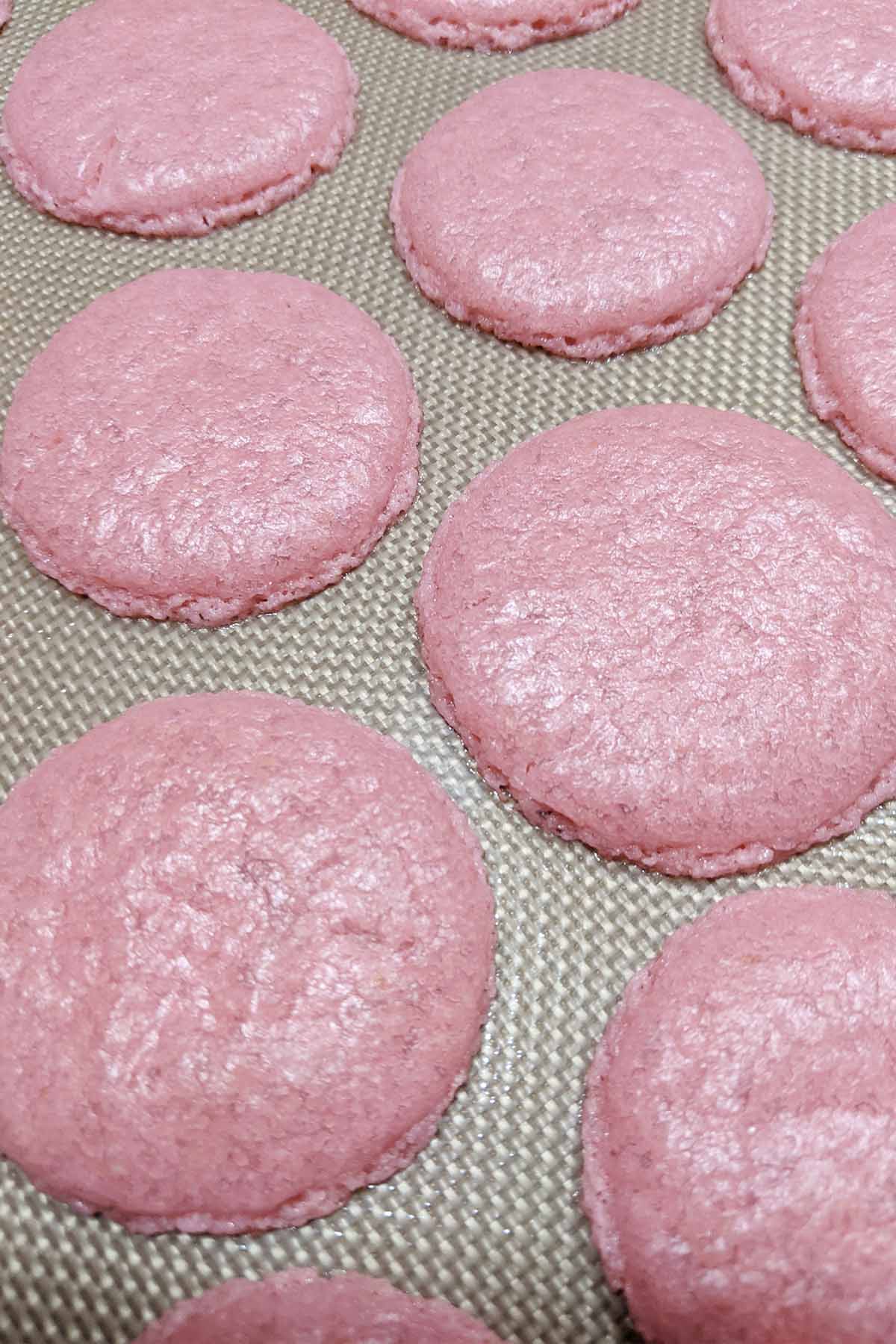
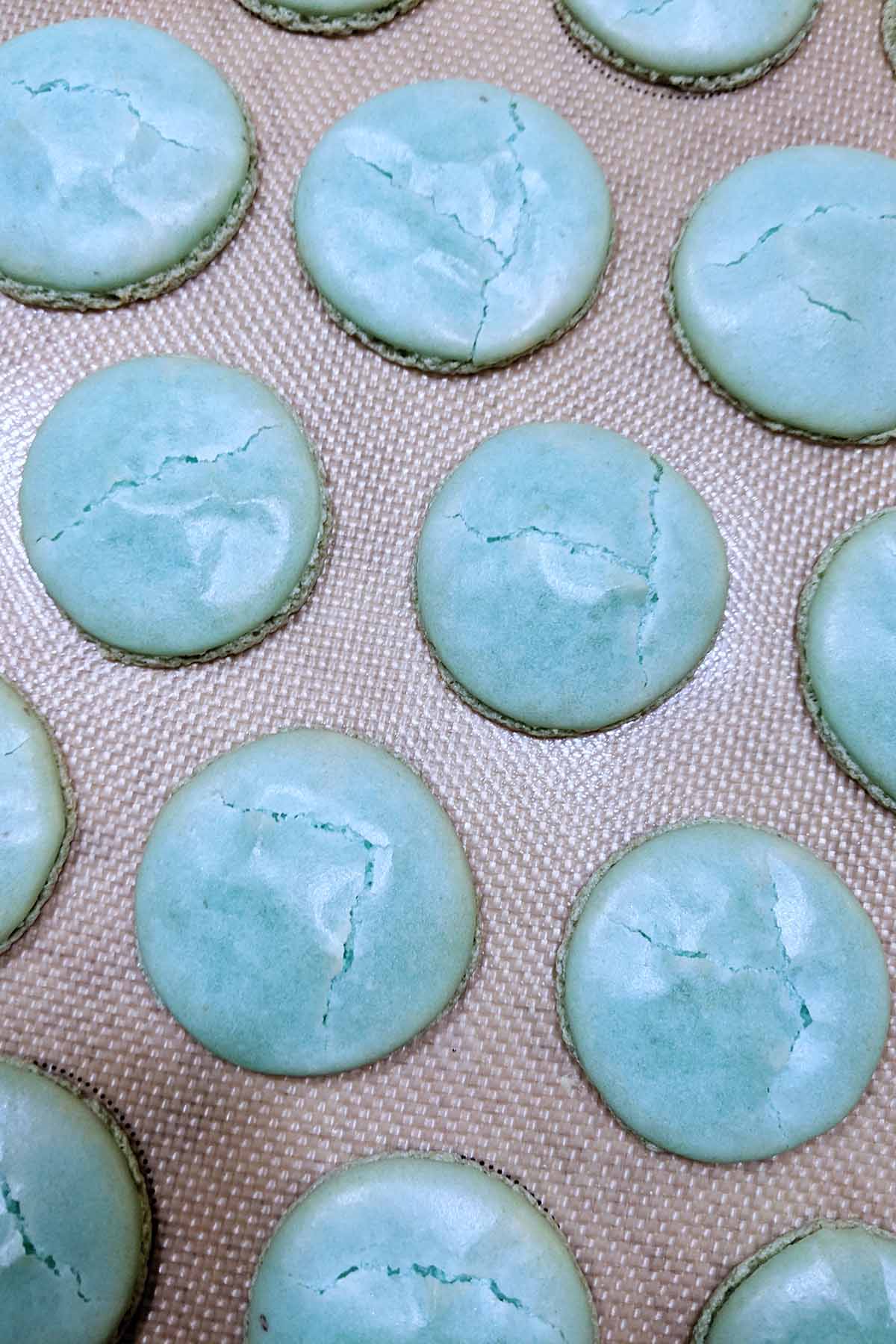
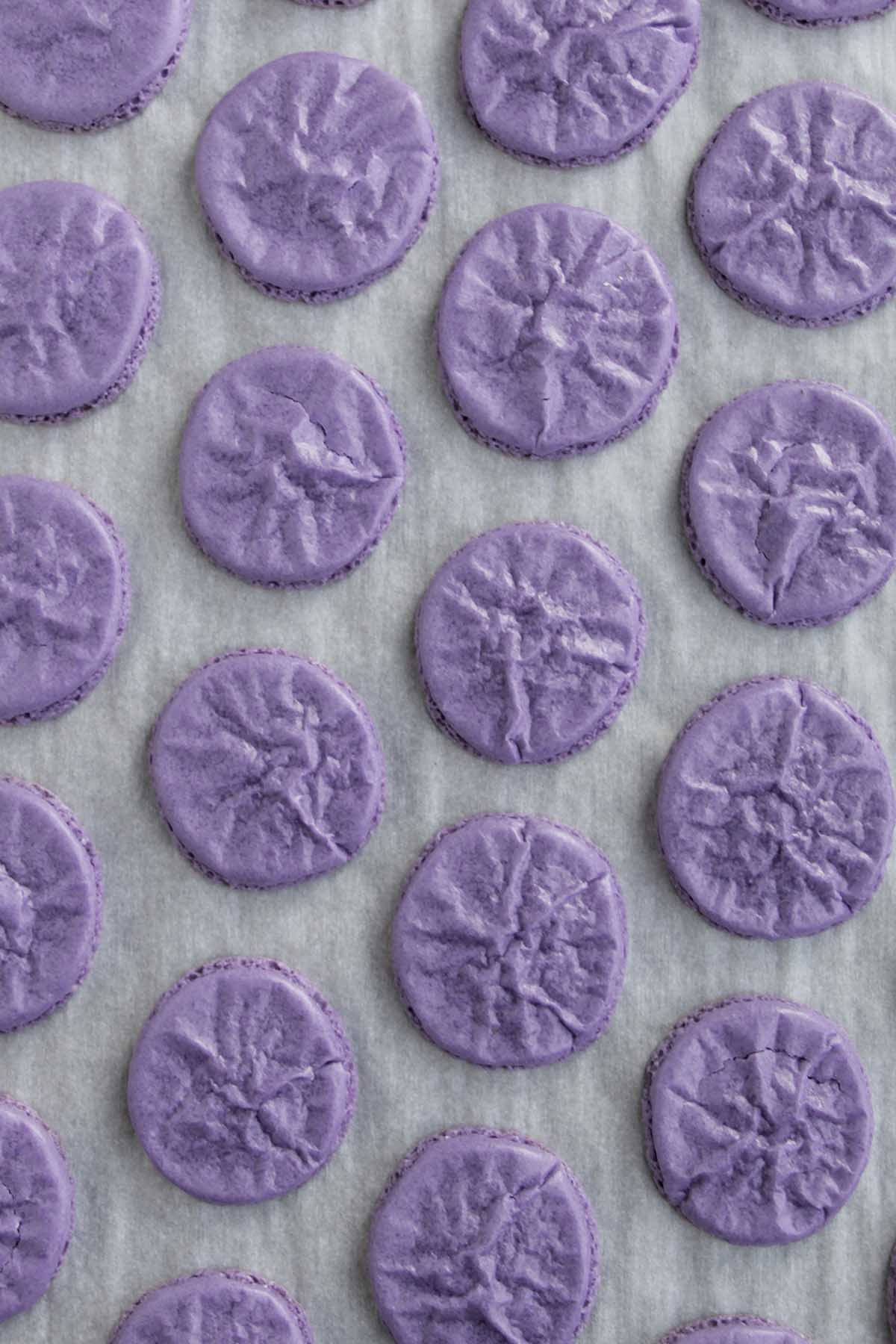
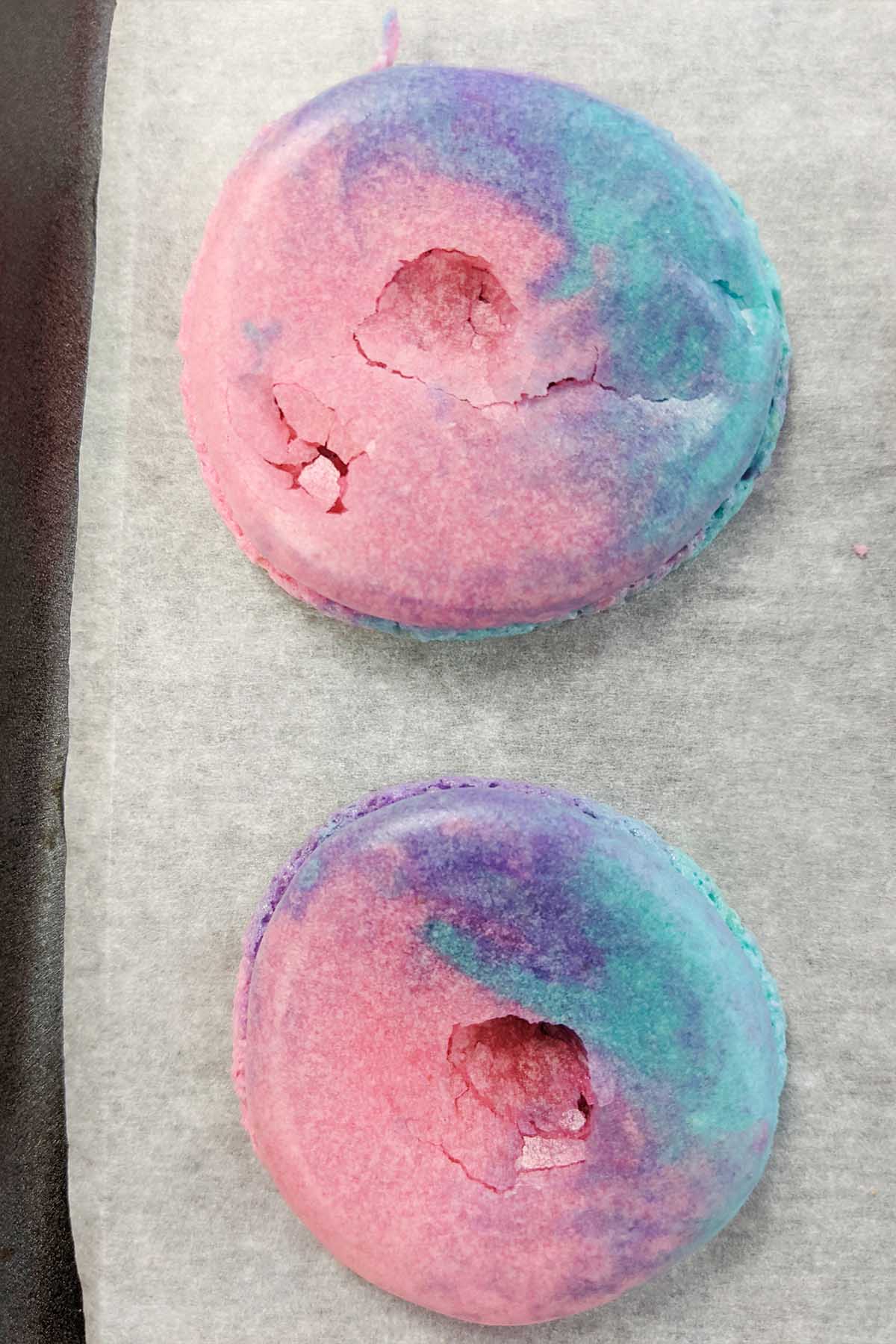
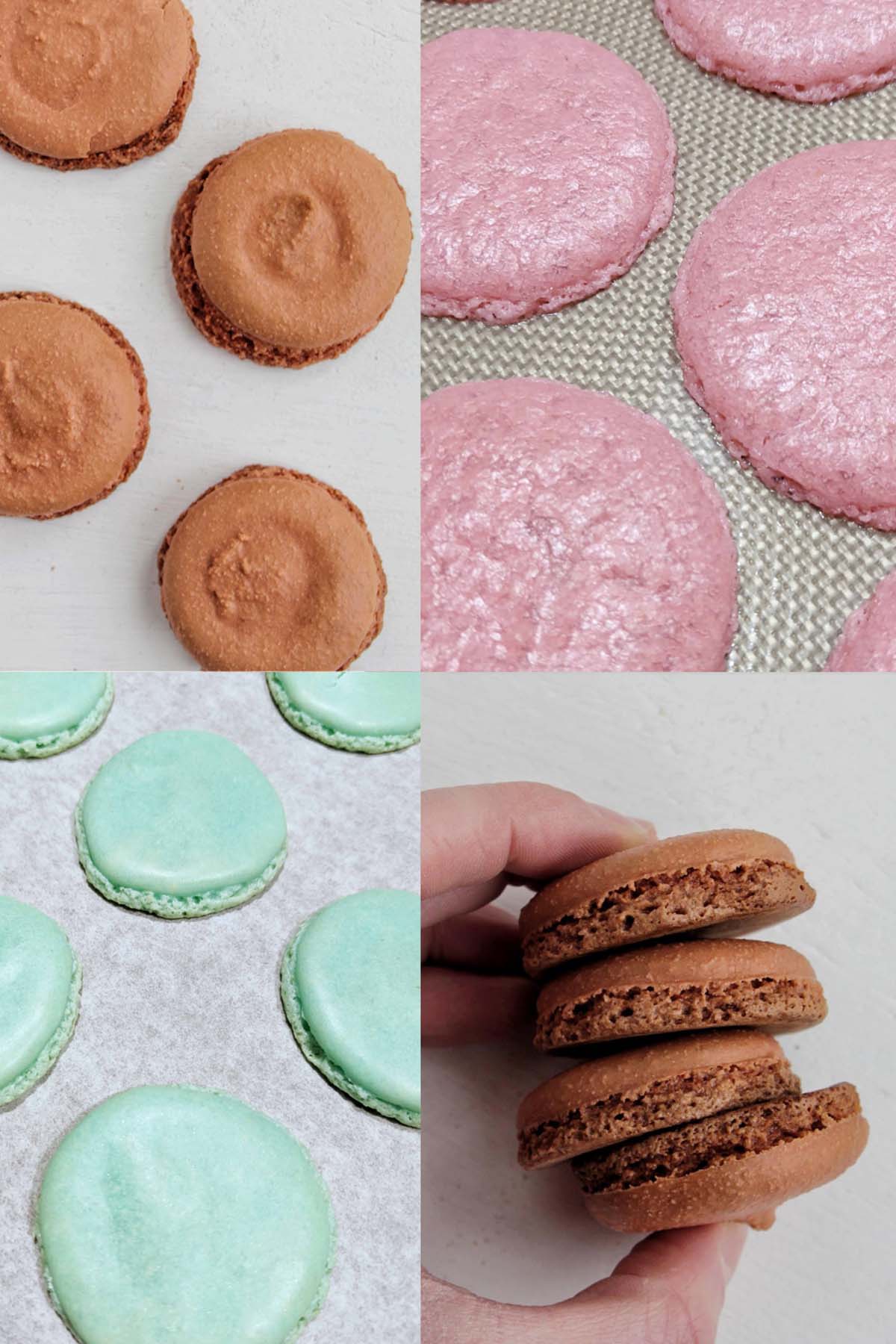
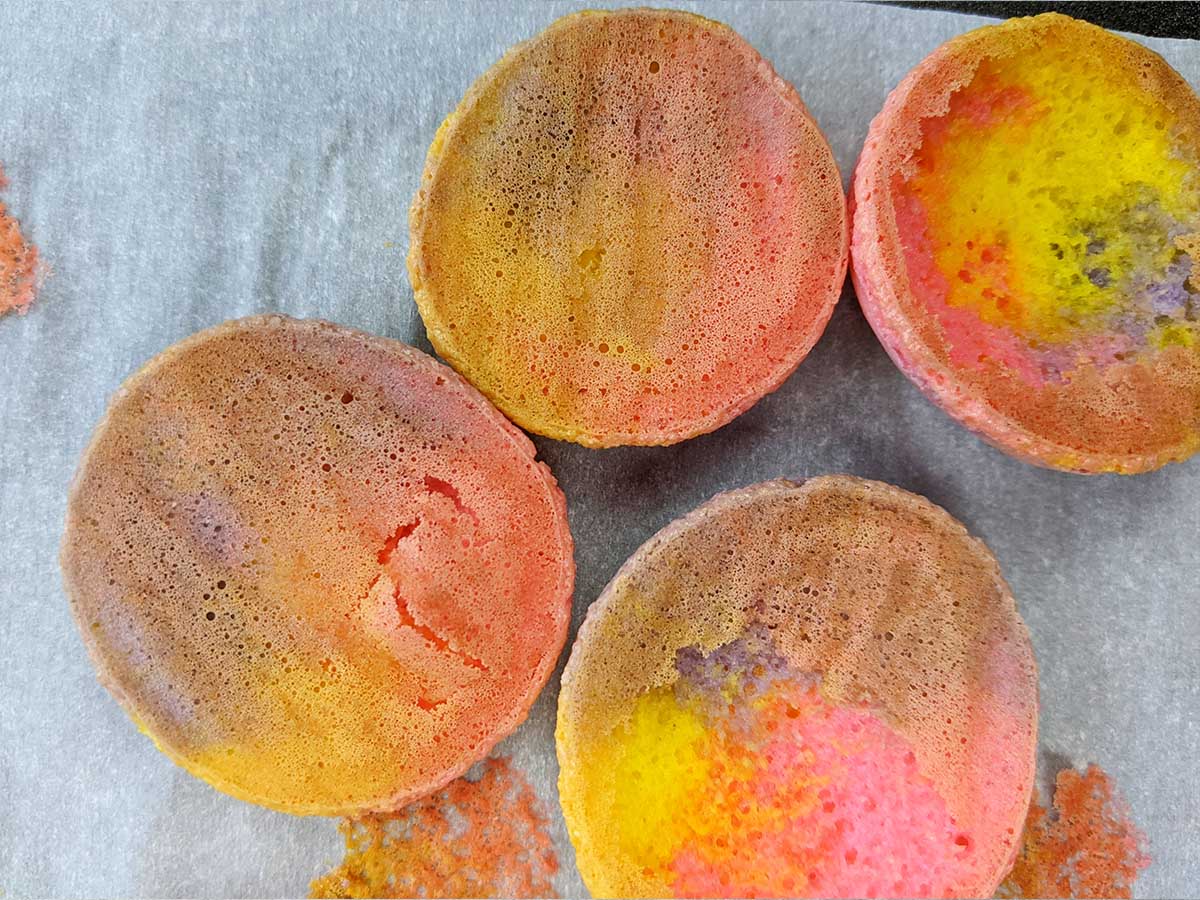
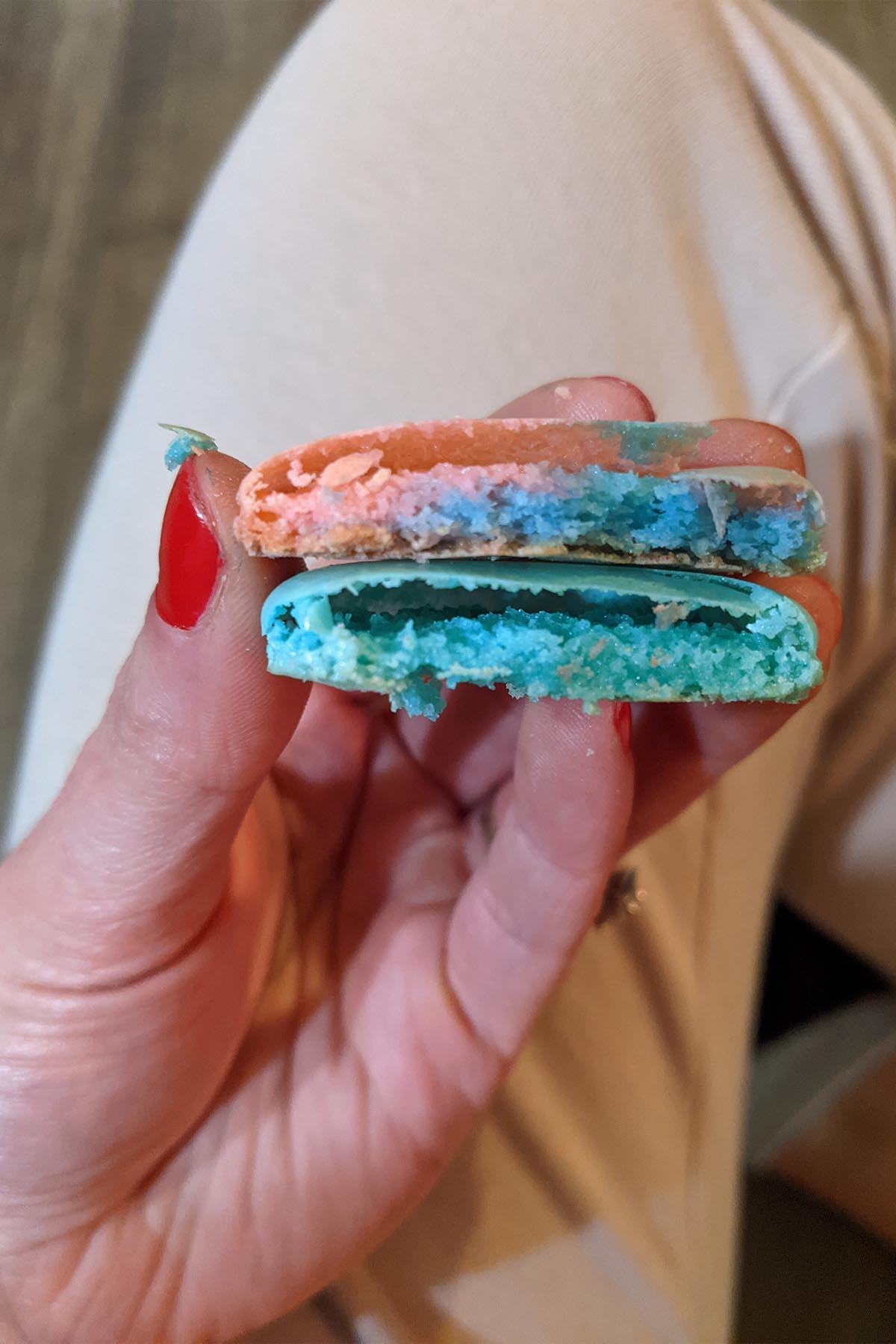
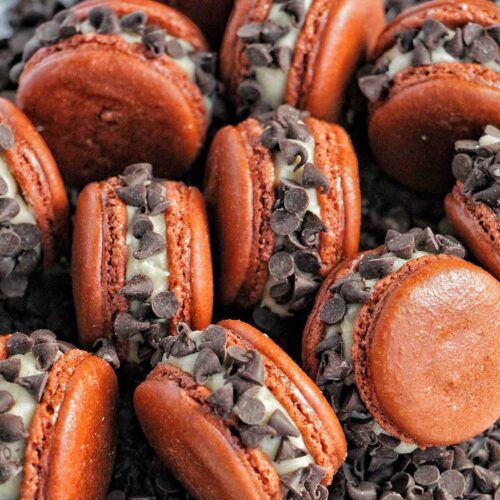
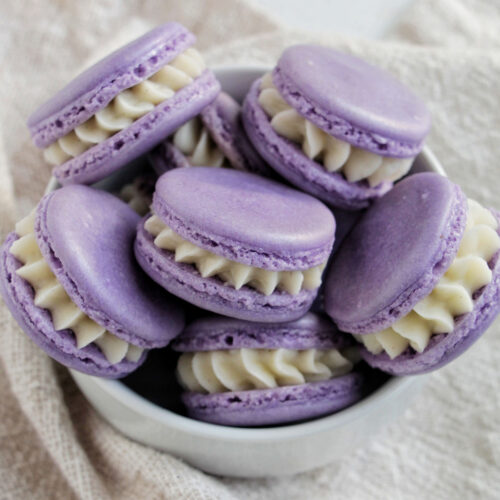
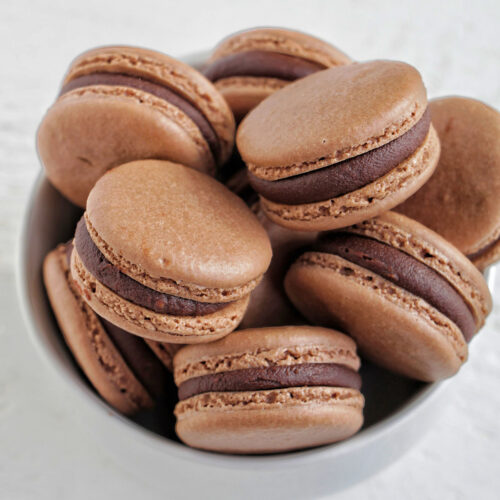

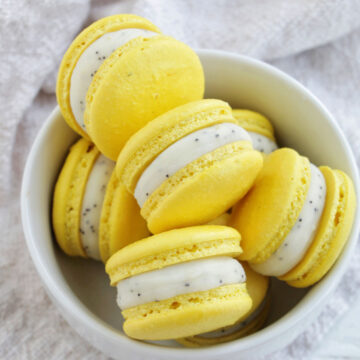
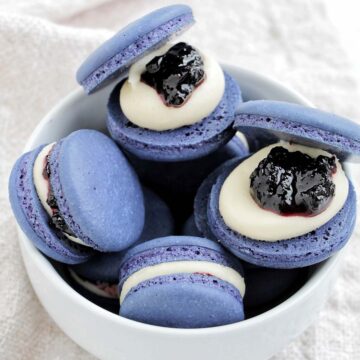
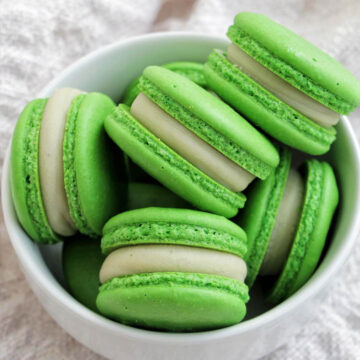
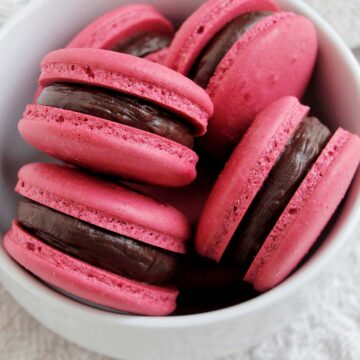

Leave a Reply